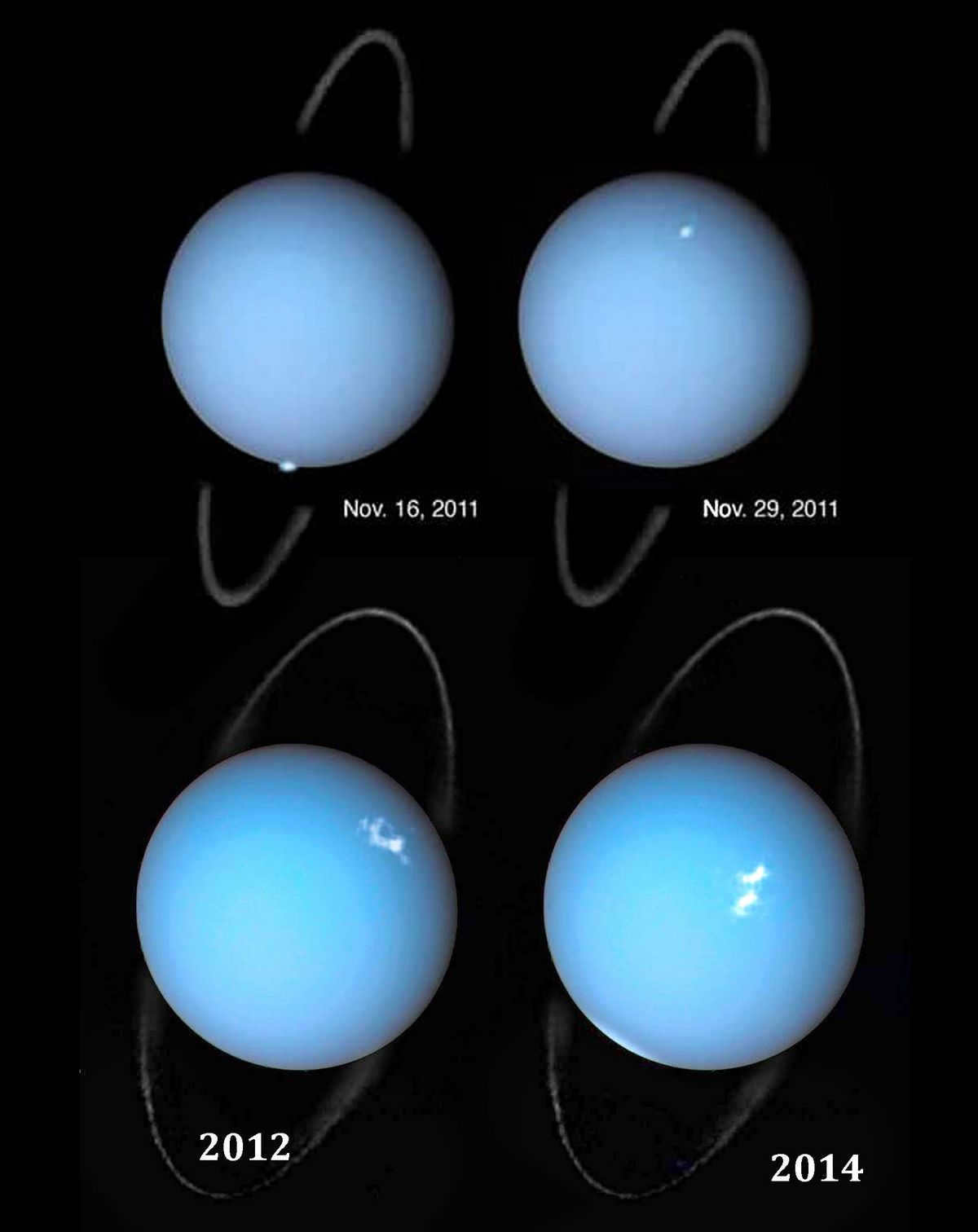Saturn’s appearance – an explanation for kids: the makeup of the planet and how it compares to other gas giants and Earth, its hydrogen atmosphere, mantle and core, its rings and magnetic field.
We will discuss the composition of Saturn in a way that children can understand. This knowledge will be beneficial for both children and their parents.
A simple explanation for young kids about Saturn’s composition can start by introducing the object. It is the 6th planet in our solar system, located in the Milky Way galaxy, and is famous for its beautiful rings. Saturn is the Roman name for the Greek god Cronus, who was a powerful titan in ancient myths. Additionally, it might be interesting for kids to learn that Saturn was associated with Saturday in the ancient calendar. To provide more information to parents or teachers in schools, it’s important to understand the different types of planets. In the image below, you can explore not only the composition of Saturn but also Jupiter, Uranus, and Neptune. The tiny Earth can be seen in the background, allowing you to compare the sizes of these planets.
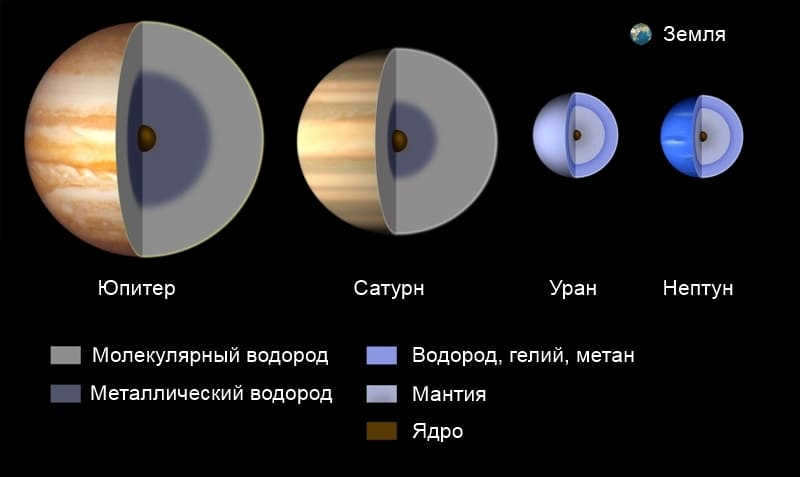

The composition of gas giants
In our galaxy, there exist only two types of planets: gas giants and solid planets. Earth, despite having an atmosphere, falls into the solid category. Gas giants typically possess a solid core, with the rest being comprised of gas. It is theorized that if gas giants like Saturn, Jupiter, Neptune, and Uranus had continued to undergo further evolution, they could have transformed into stars. However, this never occurred, so they remained as planets.
You can help children understand the size of Saturn by comparing it to Earth. Saturn’s circumference is large enough to fit 760 Earths. Scientists believe that Saturn has an iron core that is 10 to 20 times larger than Earth’s. The density of Saturn is so low that if you were to create a bathtub the size of Saturn and place it in a massive body of water, it would hold the water and even float. The majority of Saturn’s atmosphere is composed of hydrogen and helium, with smaller amounts of methane, ammonia, and water. Parents can teach their children about the different layers of Saturn’s atmosphere. Beyond the gases, there is compressed metallic hydrogen in liquid form, followed by a thick layer of hydrogen and helium. This can be demonstrated using diagrams or models in the classroom.
Explaining Saturn’s Surface to Kids
Saturn is mainly composed of gas, so there is no distinct boundary between its atmosphere and surface. This means that if a spacecraft were to attempt a landing, it would not encounter solid ground. Instead, it would quickly descend into the planet’s depths, where the intense pressure would eventually crush the spacecraft.
It’s important to clarify to children that a planet like Saturn does not have a conventional “ground.” Scientists consider the point where the pressure exceeds 1 bar (equivalent to sea level on Earth) as the surface of Saturn.
As it goes deeper, the pressure increases, and at a specific point, hydrogen transitions into a liquid state. As it moves closer to the center, it transforms into metallic hydrogen. While Jupiter has more ice, it doesn’t have as much metallic hydrogen as Saturn. Saturn’s density is lower compared to other planets, to the point where it could even float in a massive body of water.
Scientists speculate that Saturn might have a rocky core surrounded by helium and hydrogen, but they haven’t determined its solidity yet (it may be in a liquid state). Being far from the Sun, Saturn experiences constant cold temperatures. However, the temperature in its core can reach up to 11,700°C.
During its formation, the core was the first to develop, with a mass ranging from 9 to 22 times that of Earth. Then, it gravitationally attracted light hydrogen and helium gases.
An Explanation of Saturn’s Powerful Magnetic Field for Kids
It’s important for children to understand that Saturn’s magnetic field is generated by a special substance called metallic hydrogen in its liquid form. While not as strong as Jupiter’s magnetic field, Saturn’s magnetosphere is still the most powerful among all the other planets.
A Kid-Friendly Explanation of Saturn’s Rings
When the famous astronomer Galileo Galilei observed Saturn through a telescope, he noticed two round shapes on either side of the planet that appeared to be separate objects. However, it was later discovered by the Dutch astronomer Christian Huygens that those shapes were actually rings surrounding Saturn.
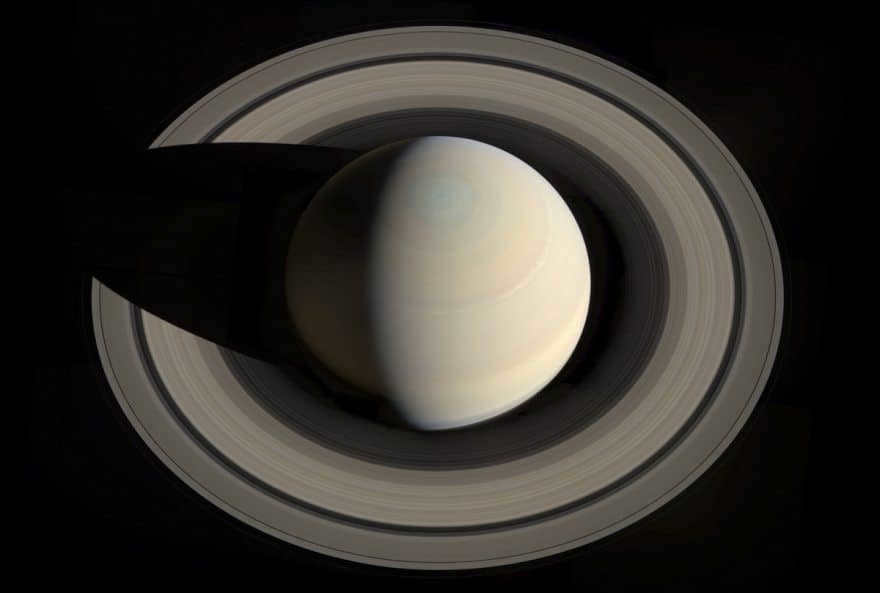

Saturn stands out for the stunning beauty of its rings, even though most gas giant representatives have some type of rings.
The rings of Saturn extend for a distance of 422,730 km (eight times its radius). Composed of ice and rock fragments, they create a mesmerizing iridescent effect as they refract sunlight.
In addition, Saturn experiences winds that sweep across its surface at speeds of 1,800 km/h. These winds are a result of Saturn being the fastest rotating planet in our solar system. This rapid rotation causes the planet to bulge significantly at its center and gives it a day length of only 10.5 hours.
There is a plethora of captivating wonders awaiting discovery on Saturn. The illustrious rings have captivated adventurers for centuries, illuminating the nocturnal expanse. Presently, we are aware that these rings are constructed from a combination of minuscule ice fragments and substantial rock formations. As the sun’s rays cascade upon these icy particles, a resplendent luminosity is produced, resulting in a breathtaking spectacle. Furthermore, it is essential for young minds to comprehend that Saturn possesses a magnetic field that exceeds ours by a staggering 578-fold.
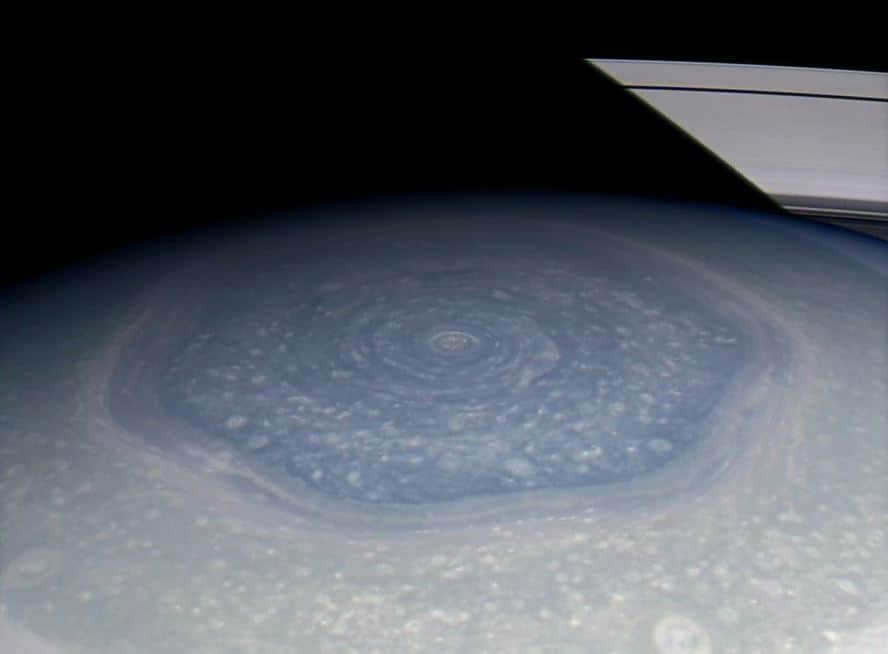
There is an unusual hexagonal formation located at the northern pole of Saturn.
There is still one more subject that scientists must investigate. Saturn’s northern pole contains a mysterious hexagonal shape spanning 12,500 kilometers. Interestingly, this shape is large enough to accommodate nearly four Earths. The origin of this formation remains unknown, although thermal images indicate that it extends approximately 100 kilometers deep.
Many individuals select their favorite planet based on factors such as color, size, or number of satellites (Saturn possesses 62). However, Saturn is particularly beloved due to its rings. Each time a mission orbits this planet, we are treated to some of the most breathtaking photographs.
The astronomy demonstration lesson has come to an end, so now let’s attempt the task of sketching the planets of our solar system using a pencil.
Step-by-step guide on drawing the planets of the solar system with a pencil
First step: Begin by drawing the planetary orbits. The shape of the orbits is similar to ellipses, although they are close to being circular. However, when viewed from a certain point, they appear as arcs or parts of ellipses, as shown in the figure. Mark the positions of the planets along these lines.
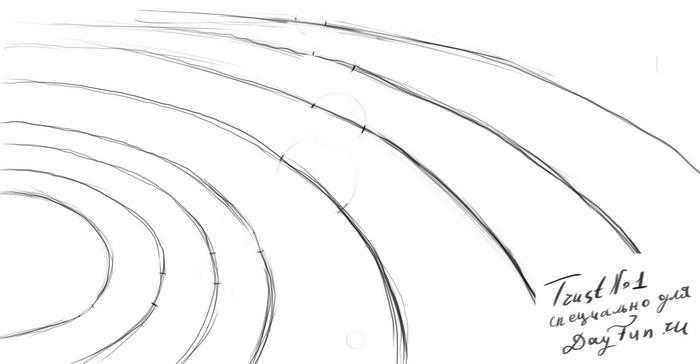 Second step: Next, draw circles to represent the planets. Start with a small circle for Mercury, followed by a larger one for Venus and Earth. Then, draw another small circle for Mars, and continue as shown in the figure. In the lower left corner, depict the edge of the Sun.
Second step: Next, draw circles to represent the planets. Start with a small circle for Mercury, followed by a larger one for Venus and Earth. Then, draw another small circle for Mars, and continue as shown in the figure. In the lower left corner, depict the edge of the Sun.
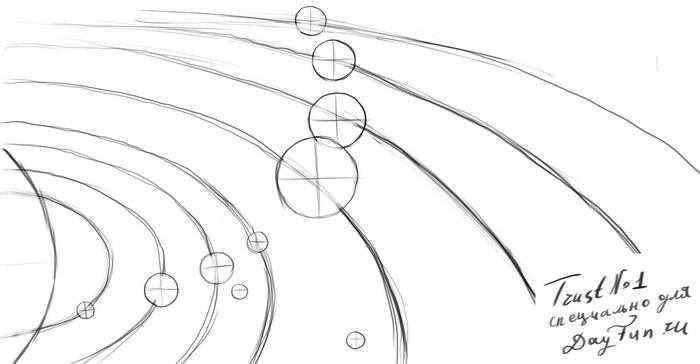 Third step: Remove the auxiliary lines, which are the axes of the circles. This will make the orbits more prominent.
Third step: Remove the auxiliary lines, which are the axes of the circles. This will make the orbits more prominent.
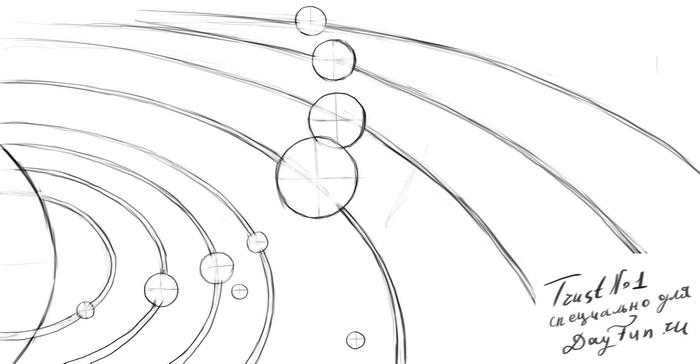 Fourth step: Add other celestial bodies, such as comets and asteroids. Draw “rings” around the larger planets.
Fourth step: Add other celestial bodies, such as comets and asteroids. Draw “rings” around the larger planets.
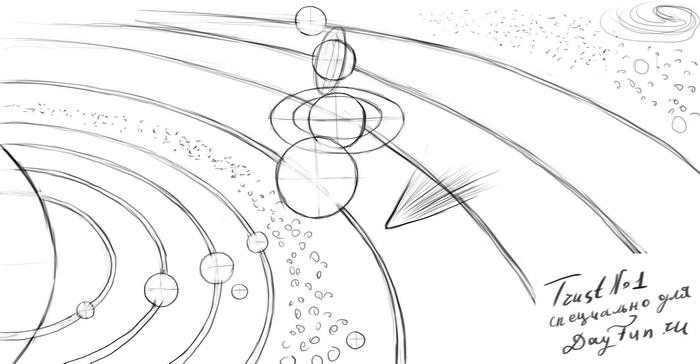 Fifth step: Create a hatching effect to give the circles a three-dimensional appearance. Keep in mind that the Sun is at the center, so the light will fall from its side. As a result, the opposite side of each planet should be shaded. The final result should be something like this:
Fifth step: Create a hatching effect to give the circles a three-dimensional appearance. Keep in mind that the Sun is at the center, so the light will fall from its side. As a result, the opposite side of each planet should be shaded. The final result should be something like this:
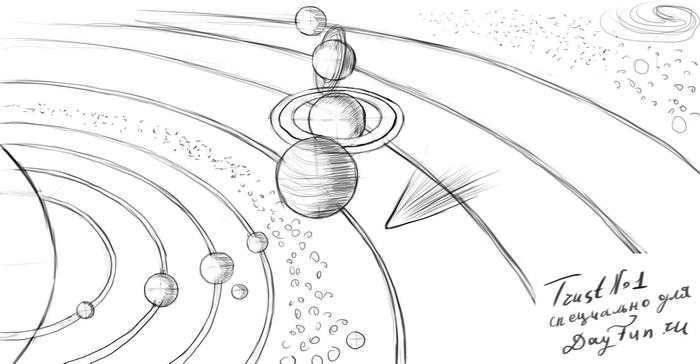 I recommend exploring more fascinating lessons with similar themes.
I recommend exploring more fascinating lessons with similar themes.
Observe the immense size of our star, the Sun, in comparison to the planets, especially our own. Each planet in our solar system orbits around the Sun, each with its own unique period of rotation. Our Earth is situated at just the right distance from the Sun, allowing for the development of life without freezing or burning. This perfect distance enables us to exist, appreciate every moment of our lives, and have the opportunity to sit by our computers and learn new things, such as drawing.
Now, let’s depict this on paper. Draw a small Sun on the left side, slightly above the planet Mercury, which is in close proximity to the Sun. As is customary, we will also include the orbit along which the planet travels. Next, we have the planet Venus.
Finally, it is our turn. Earth, the third planet from the Sun, is slightly larger than all the previous ones. Moving further away, we have Mars, which is smaller in size compared to Earth.
The Asteroid Belt, located between the orbits of Mars and Jupiter, is home to a vast number of irregularly shaped celestial bodies known as asteroids. This region, spanning a very large distance, is characterized by the absence of an atmosphere. In our solar system, Jupiter takes the crown as the largest planet.
Slightly smaller than Jupiter, Saturn holds the title of the sixth planet from the sun.
Following Saturn, we have the planets Uranus and Neptune.
As of now, it is widely accepted that there are eight planets in our solar system. Previously, there was a ninth planet known as Pluto. However, in 2008, similar objects like Erida, Makemaki, and Haumea were discovered, and they were collectively classified as plutoids. These newfound objects are considered dwarf planets.
1. Saturn was named after the Roman god Saturn in accordance with Roman mythology.
2. Currently, there are a total of 62 confirmed satellites revolving around the planet. In the forefront of the image is the colossal satellite known as Titan, which holds the title for being the largest among them all and the second largest satellite in our entire solar system. Positioned behind Titan is the satellite named Tethys. This stunning photograph was captured on November 26, 2009, courtesy of the Cassini spacecraft. The distance between Cassini and Tethys measures approximately 2.2 million kilometers, while the distance to Titan is roughly 1 million kilometers.
3. Titan stands as a remarkable celestial body in the Solar System, with the exception of Earth, for being the only surface where the existence of liquid has been scientifically confirmed. Additionally, it is the sole satellite of Saturn to possess a dense atmosphere. Throughout extensive research on Titan, there have been fascinating speculations about the presence of primitive life forms. The natural coloration of Titan further adds to its enigmatic appeal.
4. One of the images that provides evidence of liquid presence on Titan. Scientists hypothesize that the photograph, captured on July 8, 2009, reflects the illumination from one of the satellite’s numerous lakes.
6. Titan itself has a diameter twice that of the Moon, measuring 5,150 kilometers. Additionally, Titan is 80% more massive than the Moon. The surface pressure on this moon is 1.5 times higher than Earth’s atmospheric pressure. The photograph showcases a comparison in size between the Moon, Titan, and Earth.
7. Is it Titan’s shadow? Saturn’s largest moon cast on its surface. The photograph was taken from an approximate distance of 2.1 million kilometers.
8. The rings of Saturn, Titan, and Mimas.
10. On October 14, 2009, a photograph was taken of Saturn’s icy satellite, which was discovered in 1684 by Giovanni Domenico Cassini. The satellite has a diameter of 1,000 kilometers.
11. Mimas is a small satellite of Saturn, measuring only 396 km in diameter.
13. Another photograph of the satellite Mimas was taken from a distance of 9,500 km. The photograph clearly shows the enormous Herschel crater, which has a diameter of 130 km.
14. Calypso is a small satellite named after a nymph from ancient Greek mythology. It has an irregular shape and dimensions of 30×23×14 km.
15. The average distance between the Sun and Saturn is around 1,434 million kilometers, while the distance between the Earth is 1,300 million kilometers. Saturn completes its orbit around the Sun in 29.5 years, which is equivalent to 10,759 days. In terms of weight, Saturn is 95 times heavier than Earth, but its average density is only 0.69 g/cm³, making it the only planet in our solar system with a density lower than that of water. The diameter of Earth’s equator is 10 times smaller than that of Saturn. A photograph taken in September 2009 from a distance of approximately 2.7 million kilometers shows a small white dot on the lower left, which is the satellite Mimas.
16. Saturn is a gas planet primarily composed of hydrogen and lacks a solid surface. The photograph provides a comparison of the sizes of the Sun and the planets. From right to left, the order is Neptune, Uranus, Saturn, Jupiter (the four giant planets), followed by Mars, Earth, Venus, and Mercury (the terrestrial planets).
17. An image of Enceladus, another moon of Saturn (about 500 km away), captured on July 26, 2009. The surface of this satellite is significantly colder compared to the other moons of Saturn, with temperatures dropping as low as -200 °C. Using the Cassini spacecraft, scientists recently discovered that Enceladus has an ocean with water composition similar to that of Earth, including salinity. These findings enhance the possibility of life existing on Enceladus.
18. Saturn’s rings and its moon Enceladus.
19. Enceladus is covered with a layer of ice. Taken from a distance of 2,028 km by the Cassini spacecraft on November 21, 2009. Enceladus was named after a giant from Greek mythology, known as Enceladus.
21. A comparison of the size of Enceladus to Earth.
24. A section of Saturn’s atmosphere featuring clouds and the moon, Helen.
25. Prometheus is another irregularly shaped moon of Saturn.
26. Rhea, the second largest moon of Saturn, was discovered in 1672.
27. Rhea and Epimetheus are two small inner moons of Saturn. The photo was taken 1.6 million kilometers from Epimetheus and 1.2 million kilometers from Rhea, with Saturn in the background.
28. The planet Saturn and its dark side, along with Enceladus. The enigmatic rings consist of billions of tiny particles and are only 1 kilometer thick, with a diameter of 250,000 kilometers.
29. The rings are composed of numerous bands and gaps, resembling the grooves on a vinyl record.
30. Dione, another moon orbiting Saturn, was first observed by Giovanni Cassini in 1684. It bears a striking resemblance to Rhea.
32. Dione pictured in the background with Titan, Saturn’s largest moon.
The wonders of space captivate not only scientists, but also artists. It serves as an everlasting muse for creative minds. Although we cannot witness its grandeur firsthand, the photographs and videos captured by astronauts are truly awe-inspiring. In this tutorial, we will attempt to depict the vastness of space. This lesson is not overly complex, but it will provide children with a better understanding of the planets and their locations.
You will need: a sheet of paper, a pencil, an eraser, a compass.
Step 1
Start by drawing a large circle on the right side of the piece of paper. If you don’t have a circular item, you can trace around something round.
Planetary Paths
The paths of the planets, which are evenly spaced from the center.
The Central Area
The circles gradually increase in size. Naturally, they won’t fit perfectly, so draw semicircles.
The planetary paths never cross, as that would result in a collision.
Complete the illustration of the orbits
Ensure that the entire sheet is filled with semicircles. As of now, our knowledge is limited to only nine planets. However, it is possible that there are other celestial bodies that revolve in the outermost orbits.
The star at the center
Reduce the size of the central circle slightly and encircle it with a thick line to distinguish the Sun from the surrounding orbits.
Mercury, Venus, and Earth: A Unique Perspective
Let’s embark on a journey through the vastness of space and explore the wonders of our neighboring planets. As we set our sights on the cosmic canvas, we carefully arrange the planets in a specific order, honoring their distinctive orbits. Amongst them, the closest companion to the Sun is the swift Mercury. In its orbit, just a step away, we find the enchanting Venus. And gracefully trailing behind, in the third orbit, we encounter our beloved home, Earth.
Mars, Saturn, and Neptune: Unveiling Celestial Marvels
In the cosmic neighborhood surrounding Earth, we find the captivating presence of Mars. Comparatively smaller in size, it holds an undeniable allure. As we journey further, the fifth orbit awaits its cosmic tenant, still a mystery to be unraveled. And beyond that, we unveil the majestic rings of Saturn, encircling its vastness. Continuing our celestial exploration, we encounter the enigmatic Neptune, a grandeur that surpasses Earth in its immense magnitude. These celestial giants, rightly called giant planets, captivate our imagination with their sheer size, dwarfing our humble abode.
Uranus, Jupiter, and Pluto
Another massive planet, Uranus, can be found between Saturn and Neptune. To ensure that the visuals remain distinct, it should be depicted horizontally.
Jupiter, the largest planet in our solar system, will be positioned separately from the rest of the planets. Finally, let’s include Pluto, the smallest celestial body, on the ninth orbit.
Saturn’s Enigmatic Rings
Saturn is renowned for the enigmatic rings that encircle it. Illustrate these captivating features by sketching multiple ovals encompassing the central region of the planet. Extend various-sized rays emanating from the Sun to further enhance the visual appeal.
Diverse Planetary Terrains
The surfaces of planets exhibit a myriad of distinct characteristics. Even our very own Sun showcases an array of shades and intriguing black spots. Depict the surface of each planet by utilizing circles and semicircles to capture their unique topography.
When portraying Jupiter’s surface, be sure to include areas of fog, as this planet is frequently engulfed in sandstorms and veiled with clouds.
Lastly, add concentric circles to represent the Sun’s mesmerizing structure. For some planets, incorporate a shadow effect by separating it with a semicircle. Additionally, consider illustrating Earth’s satellite, the Moon, in close proximity.
Coloring
The color scheme of space is truly fascinating. In the vast expanse of the cosmos, different celestial bodies display a variety of hues. For instance, the sun radiates a vibrant yellow shade, while Mercury appears gray. Venus and Jupiter, on the other hand, showcase a rich brown color. Earth, our home planet, boasts a mesmerizing green-blue palette. Moving further, Mars is famously known for its striking red tinge, while Neptune shines in a captivating green shade. Saturn, with its sandy-colored surface, is adorned with rings that glisten in a pristine white or light blue hue, thanks to their icy composition. Uranus, with its unique blue-blue color, stands out among the celestial bodies. Lastly, Neptune presents itself in a mysterious gray-black shade. As you embark on this coloring adventure, feel free to add other details such as stars, comets, and asteroids to make your masterpiece even more captivating.
Space encompasses the vast, empty regions that exist beyond the atmospheres of celestial bodies. This step-by-step master class is designed to cater to beginner artists from junior high school and beyond. Drawing the cosmos is an incredibly fascinating activity that allows you to introduce your child to the concept of other planets, comets, and asteroids beyond Earth.
- A simple pencil
- A set of colored pencils
- A black marker or felt-tip pen

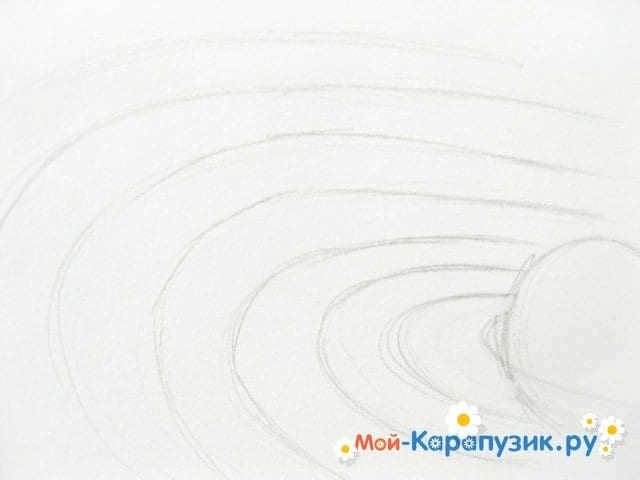
3. We will have to depict a planet on each line. Each planet varies in size and has unique characteristics. For instance, Saturn is the sixth planet from the Sun and is recognized for its ring system. Uranus also possesses rings, totaling 30 in number. Additionally, we should illustrate a comet and an asteroid field between the fourth and fifth planets. Beyond the last planet lies the Kuiper field, which is home to asteroids.
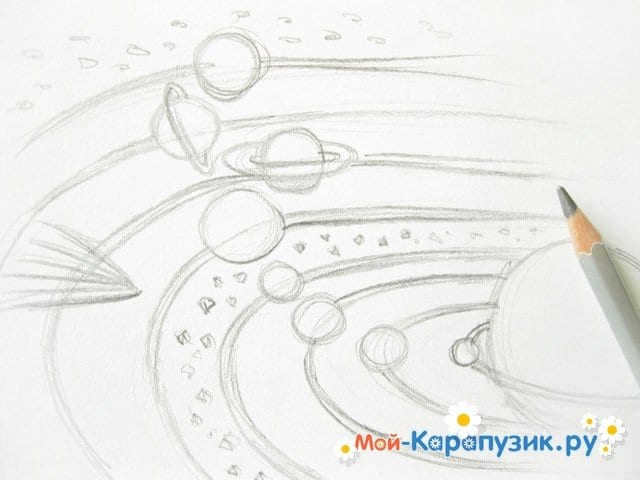
4. Use a black marker to encircle each element in the illustration.
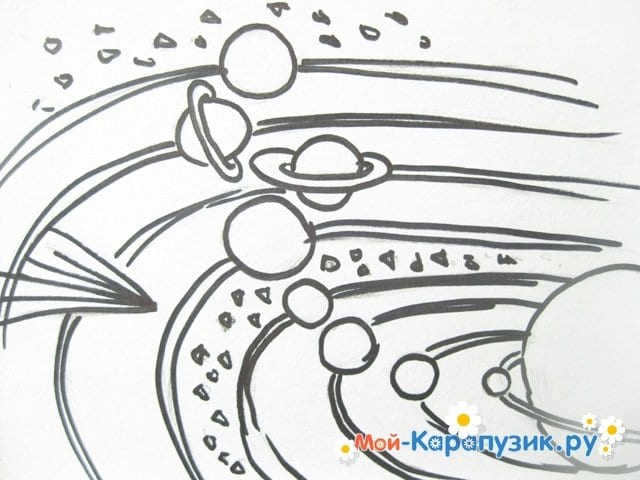
5. After completing the outline of the solar system, it is now time to add some color. We will start by giving the Sun its vibrant yellow and orange hues.
Next, we will move on to the other planets and use the same colored pencils to fill them in. Additionally, we will use an orange crayon to add some extra dimension to certain planets. As for Saturn, we will use a brown pencil to carefully color its magnificent rings.
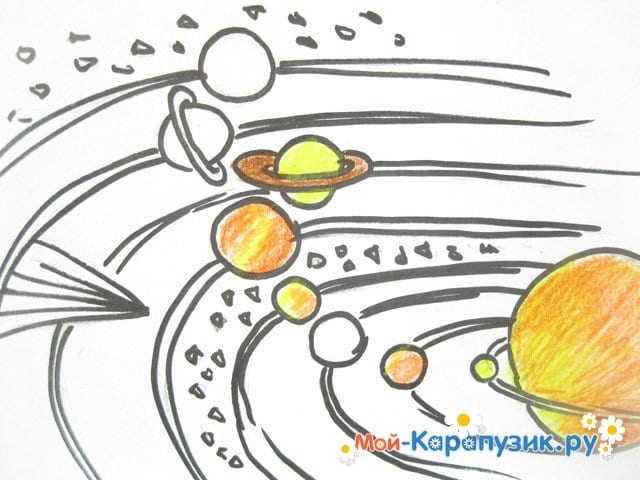
6. Next, we will proceed to the remaining planets. We will use blue and blue pencils to color Uranus and Neptune. However, our planet stands out from the rest as it boasts a variety of hues – including yellow, blue, and green. The asteroid belts will be filled with shades of brown.
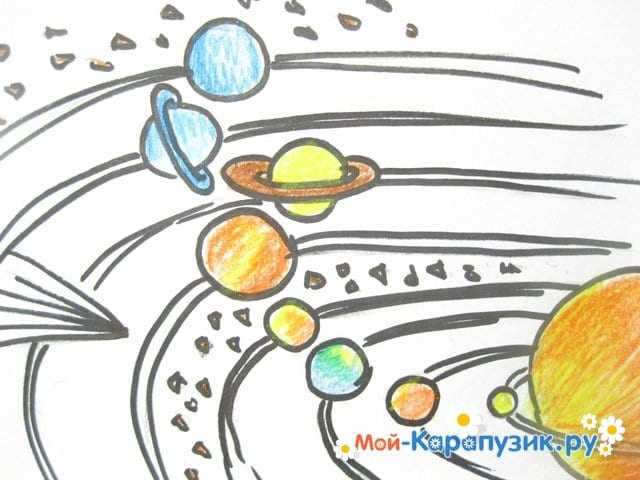
7. Let’s now bring color to the universe and the entire expanse of space.
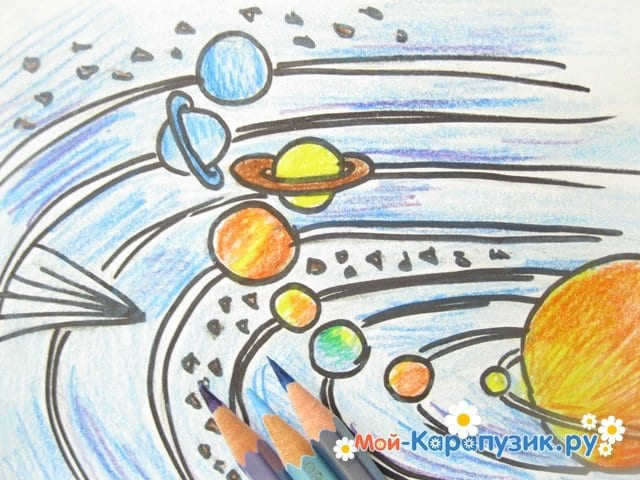
8. The depiction of the cosmos is now complete. Naturally, there are countless other elements that could be added, but let us instead embrace the power of imagination and revel in the enigmatic allure of the Universe.
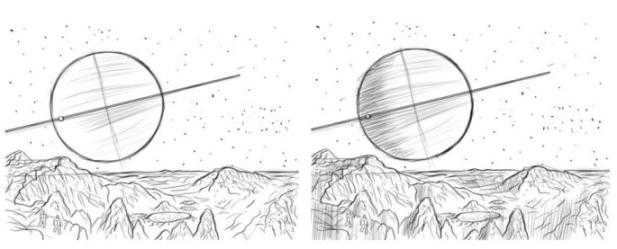
Anything mysterious and out of the ordinary always captures our attention and fascinates us. This is especially true when it comes to the encyclopedia section on space, which is particularly intriguing for children. If you take a closer look at the structure of our solar system, even a child will notice that Saturn and Neptune stand out among all the planets for their unique appearances. Saturn is known for its beautiful rings that encircle it, while Neptune has a striking blue color. After experiencing the wonder of these celestial objects, a child might be inspired to create their own depiction of the vast and unexplored expanse known as “space.” To help them bring their imagination to life, here is a step-by-step guide on how to draw the planets, specifically focusing on Saturn. Just follow the instructions and detailed explanations, and you’ll be successful!
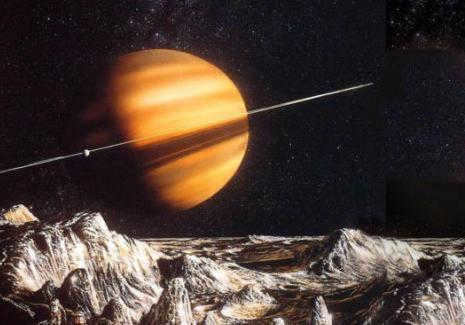
How to create a realistic depiction of planets? The ultimate secret
What is the common characteristic shared by all planets? Size? Not exactly. Let’s compare, for instance, the relatively small moon and the colossal Jupiter or Uranus. Mass? Not entirely accurate either. After all, this attribute is not directly correlated to the planet’s diameter (given the varying densities of the substances constituting celestial bodies). Color? Can we really compare the blazing Sun with any of the planets revolving around it? The answer is surprisingly simple: shape! All planets, akin to Earth, possess spherical forms. Consequently, it is relatively effortless to portray any of the members of the solar system. Begin with a circle of the desired diameter (and if necessary, multiple circles, each distinct from one another) and proceed to sketch the corresponding backdrop.
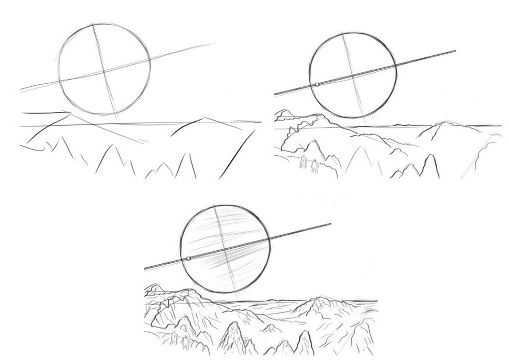
Creating a Sketch
- To begin, sketch a circular shape on a piece of paper. Typically, when drawing space illustrations, the main object is usually quite large.
- Mark two intersecting centerlines on the circle. The longer one can be referred to as the horizontal line, which will represent the rings of Saturn. Take into consideration its inclination – about 30 degrees.
- Draw the horizon line, which runs very close to the circular shape. This gives the impression that the planet is resting on the surface.
- Add a few strokes at the bottom of the sketch to represent the future lunar hills.

Tips for Drawing Saturn: Don’t Forget the Unique Features
When creating a cosmic image, whether it’s based on reality or fantasy, it’s important to include distinctive details. These details will help ensure that your drawing of Saturn corresponds to the necessary theme and looks more realistic.
- Start by sketching a landscape with mountains.
- Outline the highlands that rise above the surface.
- Add craters to some of the highland hills.
- Create a dark background for the sky.
- Include stars in your drawing.
- One side of the planet is completely obscured, so the sun’s rays do not reach its shadowy surface.
- The contours of Saturn’s rings are clearly defined.
Enhancing the Landscape: Lack of Variety
When considering how to depict planets differently from the provided image, you can draw a landscape that is undoubtedly similar to the one in the completed drawing. This is because, according to current studies, none of the other planets in the solar system, except for Earth, have any signs of life. Therefore, images of planetary terrains are not vibrant and colorful, as they lack seas and continents.
Now, when it comes to the query of “How can one sketch planets?” a suitable response would be: “It’s a breeze, really!” The insights acquired will undoubtedly prove valuable when endeavoring to portray a celestial vista.
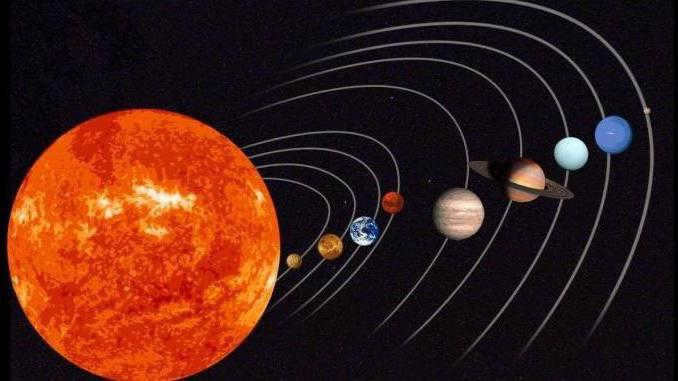
When you have kids, you get to experience the world all over again with them. You recall the wonders of the stars, the cycle of the moon, the reason for winter chill and summer warmth. And, inevitably, you eventually introduce them to the concept of the solar system.
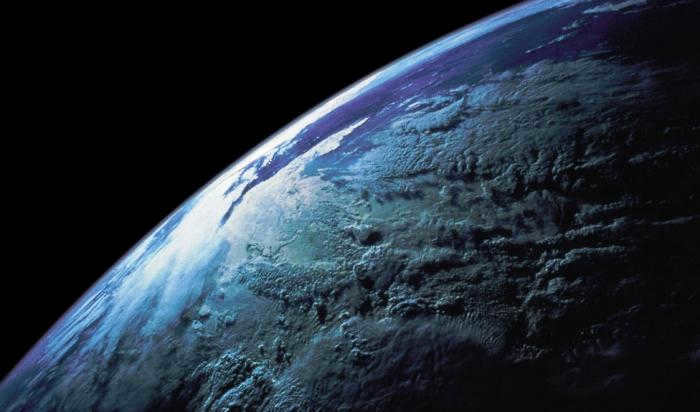
What is the best way to draw planet Earth? Since childhood, we have been trying to capture the beauty of our world using pencils, paints, or markers. However, as technology advances, traditional art tools are being replaced. Nevertheless, it is important to explore the different methods available and decide which one suits you best.
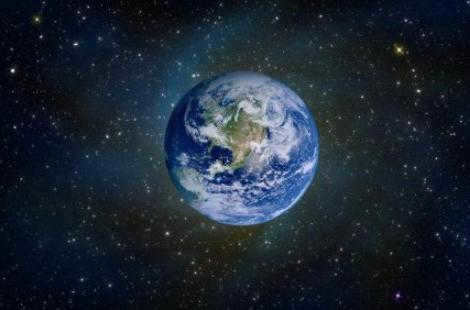
A common inquiry is how to accurately depict the Earth in a drawing. The closest resemblance can only be achieved through the replication of photographs. In this article, we will provide a detailed, step-by-step guide on recreating the image of our beloved blue planet.
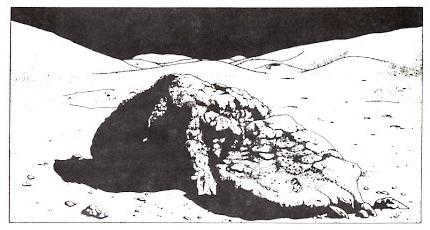
The query regarding how to depict the universe is somewhat paradoxical in essence. It is an infinite expanse of darkness, permeated by beams of luminosity. The planets, their moons, comets, and other astral entities appear as though they
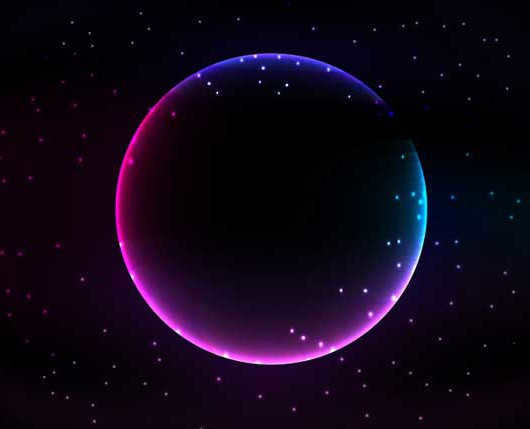

Let’s explore the technique of painting the cosmos with gouache: for the overall background, you can opt for artistic shades that are more tranquil and softer. To highlight important details in the artwork, a more vibrant and expressive poster paint would be suitable.
If you are wondering how to paint the cosmos using watercolor, gouache, or oil paints, a helpful method is to compare the different properties of these materials. Gouache, in particular, is known for its ease of application.
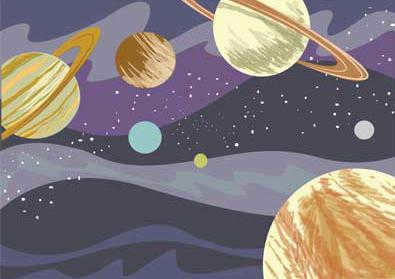

This guide provides step-by-step instructions and accompanying visuals on how to paint a realistic globe using watercolors.
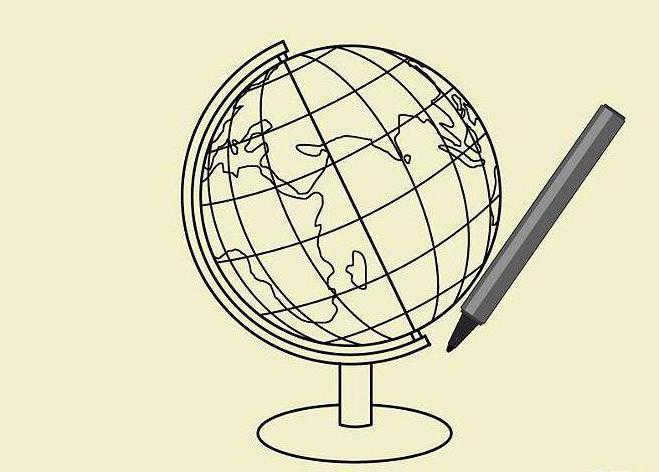
The fascination of children – and adults alike – with outer space (undiscovered planets, unknown beings and civilizations, voyages to far-off worlds) has always been unparalleled. Was it fueled by the promotion of space exploration or was it simply a result of a romantic inclination? It’s hard to say with certainty.
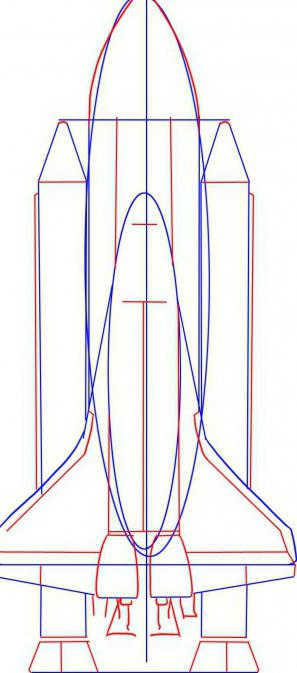
What is the best way to explain the structure of space to a child? Children at a young age have limited spatial and abstract thinking, so explaining “on fingers” would not be effective. The most effective method is to use a model of the solar system.
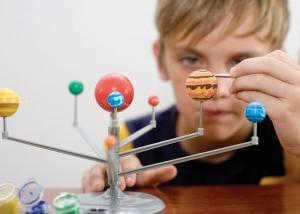

The initial human voyage into space lasted a mere 108 minutes, yet it completely revolutionized the world. Since then, Cosmonautics Day, which was officially recognized as World Day in 1969, has been celebrated every year on April 12th.
In the night sky, we can observe numerous planets from the Solar System. Even with the naked eye, we can discern that they possess distinct colors, despite resembling mere stars. For instance, Mars and Jupiter appear as reddish stars, while Saturn appears as white.
However, what color do the planets of the solar system truly possess when approached up close? After all, one specific hue must be prevalent among them. Indeed, all the planets exhibit different appearances, each for its own unique reasons. Let us delve into this inquiry, commencing in an orderly fashion.
Mercury has a gray appearance, which is evident in all photographs. This characteristic is not due to the pictures being black and white, but rather because Mercury is truly gray, albeit in varying shades.
Similar to the moon, Mercury possesses a surface that is reminiscent of the lunar landscape.
With its lack of atmosphere and a rocky terrain filled with craters, a novice might mistakenly identify a photograph of Mercury as that of the moon. In reality, they share striking similarities in their landscapes and color tones.
Venus
Venus appears with a stunning combination of yellow and white hues. What we witness here is not the actual surface of the planet, but rather the upper layers of its dense and thick atmosphere, specifically the clouds within those layers. These clouds consist of sulfuric acid, which imparts the distinctive acidic coloration. Unfortunately, due to the constant presence of the thick cloud cover, the actual surface of Venus remains perpetually hidden from view.
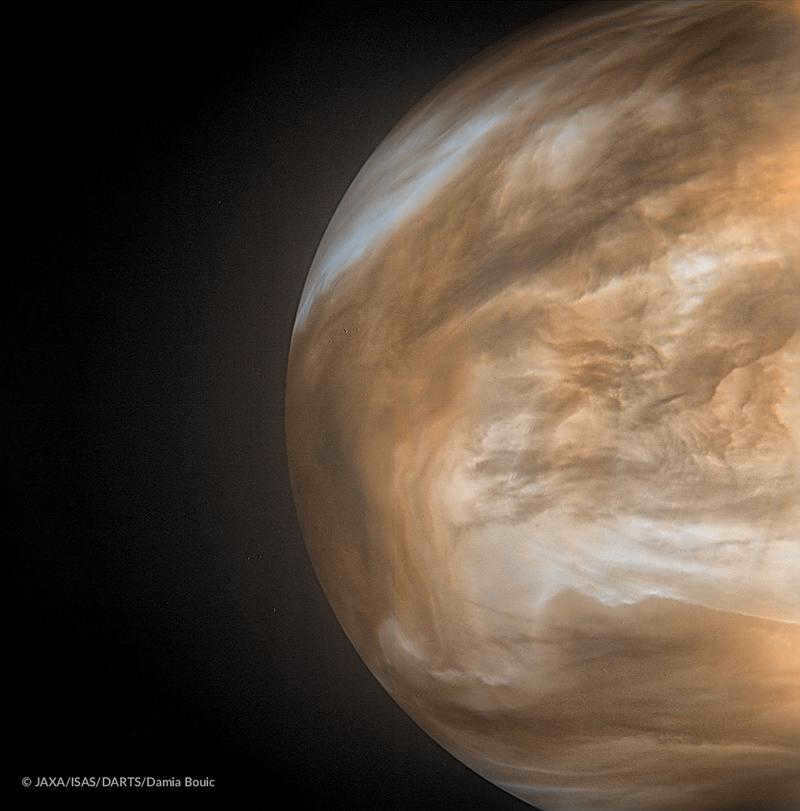
Venus can be seen in the sky as a bright star with a gentle yellow hue.
Planet Earth
The planet Earth is known as the “blue planet” due to its light blue color. This is not only because of the vastness of the oceans, which cover 70% of its surface. Earth also has a dense atmosphere that bends light, causing red rays to be absorbed and allowing blue rays to pass through freely.
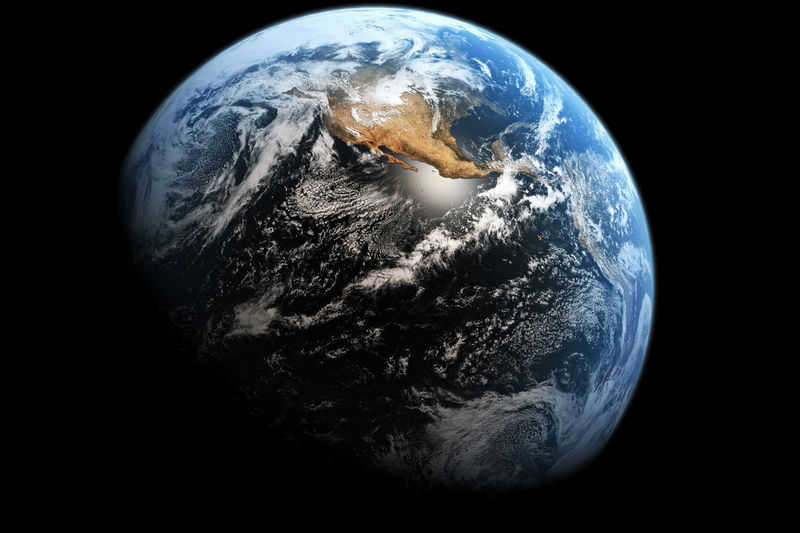
That is the reason why we perceive the sky as the color blue. And if you observe the Earth from outer space, you can witness how the atmosphere surrounds the planet like a blue cocoon.
The sky of our planet is filled with white clouds composed of water vapor. Consequently, when viewed from a distance, our planet appears as a light blue hue, rather than a pure blue shade.
Mars
Mars is characterized by a red-orange hue. It possesses an atmosphere, albeit a thin one, with minimal cloud cover. This lack of cloud interference allows the predominantly red or orange-colored surface to be prominently visible. Due to this distinct characteristic, Mars has long been referred to as the “Red Planet”.
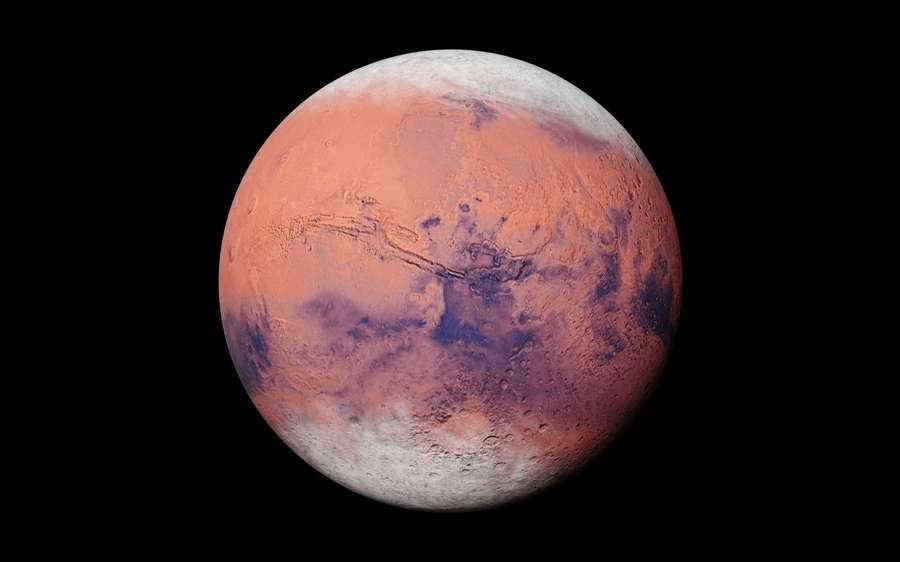
It is a known fact that the Martian soil contains a high concentration of iron, specifically its oxides. These oxides are commonly known as red rust, which gives Mars its distinct reddish hue.
Occasionally, Mars experiences global dust storms that envelop the entire planet, resulting in a uniform yellow-red appearance.
Jupiter
Jupiter appears as an orange star in the Earth’s sky, but it is actually a gas giant without a solid surface. We can only see the upper layers of its atmosphere, which are divided into distinct bands of orange and white. The orange bands are composed mainly of ammonium hydrosulfide clouds, while the white bands are dominated by ammonia clouds. Therefore, the overall coloring of Jupiter is a combination of these two colors, with orange and white being roughly equal in prominence.
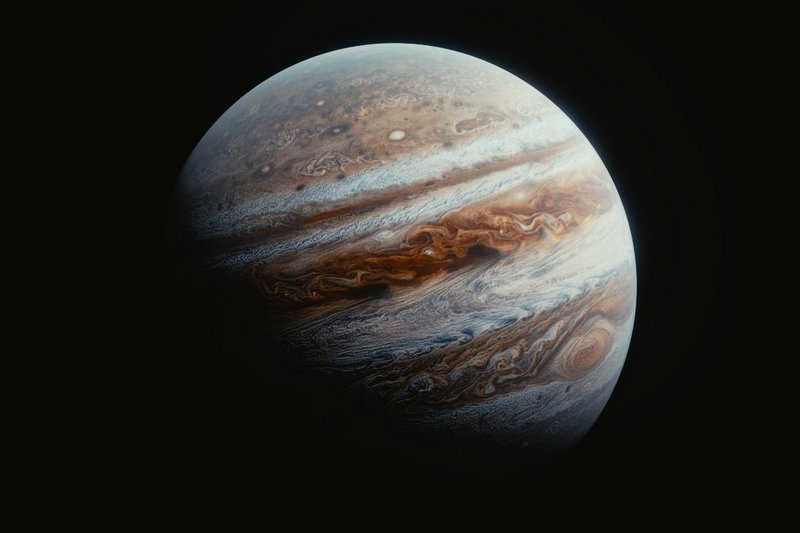
Jupiter is the largest planet in the solar system.
Saturn
Saturn is characterized by a pale yellow hue. Similar to Jupiter, Saturn is a gas giant, which means that we can only observe its upper atmospheric layers and clouds. Just like Jupiter, Saturn also showcases bands of various colors, although they appear more blended rather than distinct.
Furthermore, the outermost layer of clouds consists of ammonia, which hampers our ability to discern specific details. This ammonia layer obscures the reddish layer beneath it, resulting in a fusion of the upper and lower layers that gives Saturn its light yellow color.
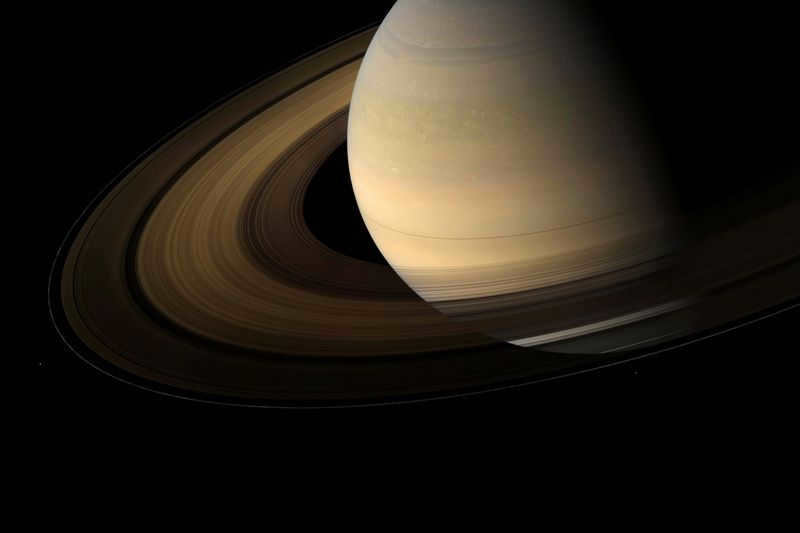
In the celestial sphere, it appears as a bright star with a slightly golden hue. When observed through a telescope, its color is a light shade of yellow.
Uranus
Uranus possesses a delicate shade of blue. Being a gas giant, only its uppermost cloud layer is visible to us. These clouds are composed of methane, hence their blue hue. The lower cloud layer is comprised of hydrogen sulfide with a yellowish tint, as well as white ammonia clouds. While these substances can be faintly observed on the planet’s surface, they do not significantly impact its overall color. The layers below remain obscured from view.
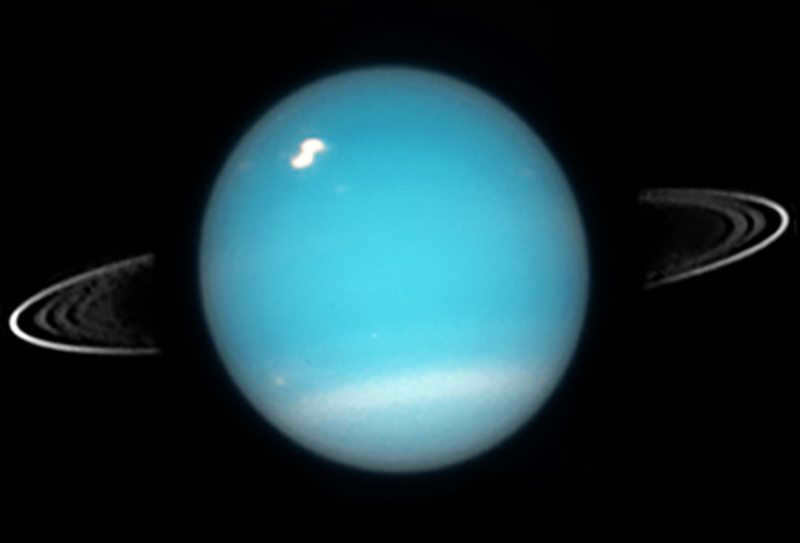
The bluish hue of Saturn in the picture is a result of the presence of methane in its atmosphere.
When observed through a telescope, Saturn also appears blue. It can be referred to as a “blue planet” similar to Earth.
Neptune
Neptune shares a similar pale blue color with Uranus. This is caused by the abundance of methane in its upper atmosphere. Methane absorbs red light, resulting in a blue and cyan appearance. However, Neptune appears more vibrant and is closer to blue than cyan in photographs.
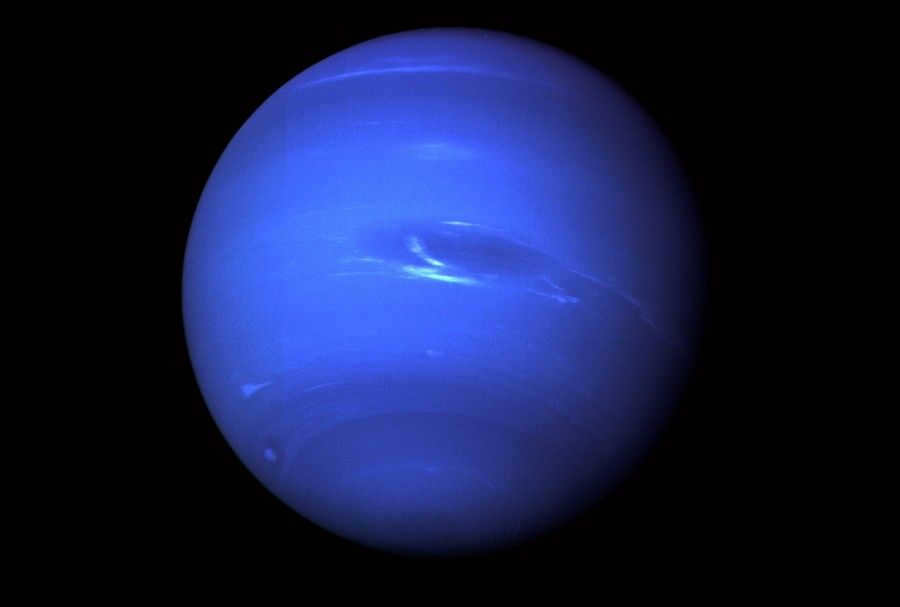
The color of Saturn in the picture is not clear.
Its color is deep blue, almost blue. This is because Saturn is located further away from the Sun, which means it receives less light. As a result, the blue color appears darker, almost blue. It is possible that there is another unknown component in its atmosphere, along with methane, which absorbs red light and gives Neptune a more intense color.
What are the colors of the planets in the solar system – final thoughts
Displayed in the image below are the primary colors of all the previously mentioned planets in the solar system.
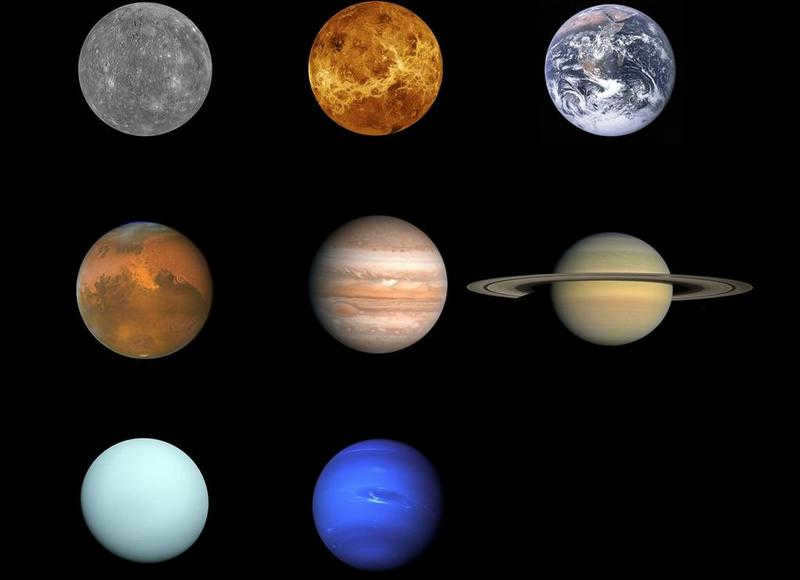
The color of each planet in the solar system.
In accordance with Jyotish, every planet possesses its own unique color that reflects its characteristics. Having knowledge of which colors correspond to each planet, as well as the days of the week and directions, can provide significant assistance in your everyday life. Indeed, colors have a profound impact on our subconscious.
Colors and planets
Colors: gold, red, orange, yellow
Colors: silver, white, milky, light blue
Qualities: calmness, happiness, inspiration
Qualities: activity, initiative, dynamism, efficiency
Colors: green, emerald
Qualities: wealth, abundance, intelligence, communication
Qualities: optimism, development, spirituality, wisdom
Colors: pink, variegated, pastel colors
Qualities: love, compassion, joy, prosperity
Colors: blue, purple, black.
Qualities: hard work, discipline, patience.
How to apply this knowledge
1) As the days of the week are associated with different planets, it’s considered auspicious to dress in the corresponding color of the planet on that particular day. By following this simple practice, you can balance the influence of the planets on your life and enhance specific areas.
2) If a planet in your horoscope is weak and you wish to strengthen it, wearing clothes in the color associated with that planet can be an effective remedy. You can also incorporate this color into your surroundings, be it at home, in the office, or wherever you go.
3) Given that each planet governs a specific direction, it is advisable to arrange your living space in a manner that incorporates elements of the corresponding color scheme in each direction. For instance, by incorporating more green in the northern region of your home, you can significantly enhance your interpersonal abilities and augment the inflow of prosperity.
Saturn, the sixth planet in our solar system, is located at the sixth position from the Sun.
Named after the ancient Roman god of agriculture, Saturn is classified as a gas giant.
Humans have been aware of Saturn’s existence since ancient times.
Jupiter and Uranus are Saturn’s neighboring planets. Together with Neptune, these four planets occupy the outer region of our solar system.
Scientists believe that at the core of this gas giant lies a massive concentration of solid and heavy materials such as silicates, metals, and water ice.
The magnetic field of Saturn is generated by the dynamo effect of circulating metallic hydrogen in its outer core. This magnetic field closely resembles a dipole, featuring north and south magnetic poles.
Out of all the planets in our solar system, Saturn boasts the most prominent and striking ring system.
So far, researchers have discovered a total of 82 natural satellites orbiting around Saturn.
Saturn’s path around the Sun
The average distance between the Sun and Saturn is approximately 1,430 million kilometers (9.58 astronomical units).
The point in Saturn’s path closest to the Sun, known as perihelion, is about 1,353.573 million kilometers (9.048 astronomical units) away.
On the other hand, the farthest point in Saturn’s orbit from the Sun, known as aphelion, is about 1,513.326 million kilometers (10.116 astronomical units) away.
With an average orbital velocity of approximately 9.69 kilometers per second, Saturn takes about 29.46 Earth years to complete one revolution around the Sun.
For Saturnians, a year consists of 378.09 Saturnian days.
The distance between Saturn and Earth can vary between 1,195 and 1,660 million kilometers.
Similar to most other planets in the solar system (except Venus and Uranus), Saturn rotates in the same direction as its orbit around the Sun.
3D representation of Saturn
Physical attributes of Saturn
Saturn is the second largest celestial body in our solar system.
The mean radius of Saturn is approximately 58,232 ± 6 kilometers, equivalent to about 9 times the radius of Earth.
Saturn boasts a surface area measuring about 42.72 billion square kilometers.
The average density of Saturn is estimated to be around 0.687 grams per cubic centimeter.
The free fall acceleration on Saturn is observed to be 10.44 meters per second squared (1.067 g).
The mass of Saturn is calculated to be about 5.6846 x 10^26 kilograms, which is roughly 95 times the mass of Earth.
The Composition of Saturn’s Atmosphere
Saturn’s atmosphere is primarily made up of hydrogen, which accounts for approximately 96% of the composition, and helium, which makes up about 3%.
As one delves deeper into Saturn’s atmosphere, both pressure and temperature steadily increase, causing hydrogen to undergo a gradual transition into a liquid state. At a depth of 30,000 kilometers, the hydrogen becomes metallic, and the pressure reaches an astounding 3 million atmospheres.
In addition to its unique composition, Saturn’s atmosphere is also known for occasionally generating powerful and long-lasting storms.
These storms often result in the observation of intense lightning discharges on the planet.
One of the most captivating phenomena in Saturn’s atmosphere is the presence of bright and continuous oval-shaped rings of polar lights that encircle the planet’s poles.
Comparison of Saturn and Earth Sizes
Saturn’s Magnificent Rings
The rings of Saturn have an estimated diameter of 250,000 kilometers and a thickness of no more than 1 kilometer.
Scientists categorize Saturn’s ring system into three primary rings and a fourth, thinner ring. In reality, the rings are composed of thousands of individual rings interspersed with gaps.
The ring system is primarily comprised of ice particles (approximately 93%), with smaller amounts of heavy elements and dust.
The particles that make up Saturn’s rings range in size from 1 centimeter to 10 meters.
The rings are inclined at an angle of around 28 degrees to the ecliptic plane. Consequently, their appearance varies depending on the relative positions of Saturn and Earth, appearing as both complete rings and as a thin line when viewed from an edge-on perspective.
When Galileo Galilei first observed Saturn through a telescope in 1609 – 1610, he noticed that the planet appeared to be three bodies that were almost touching each other. He assumed that these were two large “companions” of Saturn, but two years later he did not find any evidence to support this hypothesis.
In 1659, Christian Huygens used a more powerful telescope and discovered that the “companions” were actually a thin, flat ring that encircled the planet without touching it.
In 1979, the Pioneer 11 automatic interplanetary station flew near Saturn for the first time in history. It captured images of the planet and some of its satellites, and also made the discovery of the F ring.
Voyager-1 and Voyager-2 paid a visit to the Saturn system in 1980-1981. While getting closer to the planet, they captured numerous high-resolution images and collected data on the temperature, density, and physical attributes of Saturn’s atmosphere and its moons, such as Titan.
Starting from the 1990s, the Hubble Space Telescope has conducted multiple studies on Saturn, its rings, and its moons.
The Cassini-Huygens mission was launched in 1997 with the goal of reaching Saturn. After a 7-year journey, the spacecraft entered orbit around the planet on July 1, 2004. In January 14, 2005, the Huygens probe separated from the spacecraft and descended to the surface of Titan, collecting samples of the atmosphere. Over the course of 13 years, the Cassini spacecraft greatly expanded scientists’ understanding of Saturn’s system. The mission came to an end on September 15, 2017, when the spacecraft was plunged into Saturn’s atmosphere.
Saturn stands out among the planets in our solar system with its average density of 0.687 grams per cubic centimeter, which is lower than that of water.
With temperatures reaching 11,700 degrees Celsius, Saturn emits 2.5 times more energy into space than it receives from the Sun.
Saturn’s north pole is home to a massive hexagon-shaped cloud formation, with each side measuring approximately 13,800 kilometers.
Several of Saturn’s moons, including Pan and Mimas, serve as “ring shepherds” by using their gravity to help maintain the position of the rings through resonance with specific parts of the ring system.
Scientists believe that Saturn will absorb its rings within the next 100 million years.
In 1921, there was a rumor circulating that Saturn’s rings had vanished. This misunderstanding arose because, during the time of observation, the ring system was edge-on to the Earth and could not be seen with the technology available at the time.
Most people are aware that Saturn, the 6th planet from the Sun, is known for its rings. However, not everyone is familiar with the color of Saturn itself. Nevertheless, even with a basic telescope or a pair of astronomical binoculars, one can observe that Saturn displays a spectrum of hues ranging from a light yellow to an orange tone.
Image credit: spaceworlds.ru
There are two primary theories regarding the origin of this celestial object:
- The contraction theory suggests that Saturn was formed in the early stages of the solar system, simultaneously with the other planets, through the formation of massive “thickenings” in the gas and dust disk.
- The accretion theory proposes that the system formed in two stages. In the first 200 million years, solid and dense celestial bodies, similar to the Earth, were formed. Later, the gas giants, like Saturn, began to form from the primary protoplanetary cloud.
Saturn possesses the following main characteristics:
- Equatorial radius – 60,000 kilometers
- Polar radius – 55,000 kilometers
- Mass – 500 sextillion metric tons (10^21)
- Average density – less than 0.7 g/cm^3
- The linear velocity of rotation around its axis is 9.87 km/s (at the equator);
- The axial rotation period is 10.5 Earth days;
- The average distance from the Sun is 1.4 billion km;
- The period of rotation around the Sun is 378 Earth days;
- The orbital velocity is 9.79 km/s.
The atmosphere of the planet
The atmosphere of Saturn is composed of a combination of hydrogen and helium, with a small amount of water vapor, ammonia, and various hydrocarbons.
The yellow hue of Saturn is caused by the presence of white ammonia crystals that settle on the upper layers of the red-ochre clouds, which are formed by a mixture of ammonium sulfide and water vapor.
Winds on Saturn
The existence of powerful winds on Saturn has been confirmed by the interplanetary research program, “Voyager”. These winds can reach speeds of up to 500 m/s and predominantly blow from west to east, parallel to the planet’s axial rotation.
While the most intense air movements occur at the equator, the strength of the winds decreases as we approach the poles. Additionally, atmospheric currents blowing from east to west also emerge. This circulation pattern is present not only in the upper layer of Saturn’s atmosphere, but also extends below, reaching depths of at least 2,000 kilometers.
Super powerful hurricanes, similar to cyclones and anticyclones on other gas giants in the solar system, frequently occur in the atmosphere of Saturn. One notable hurricane is called the Great White Spot, which appears in the planet’s northern hemisphere every 30 years during the summer solstice.
The most recent occurrence of the Great White Spot was observed in 2010. Later that year, the Cassini spacecraft captured an image of another Saturnian storm that resembled a plume of smoke from a cigarette. In May 2011, the same spacecraft detected a planetary-scale hurricane in the form of a massive vortex with a diameter of approximately 5,000 kilometers.
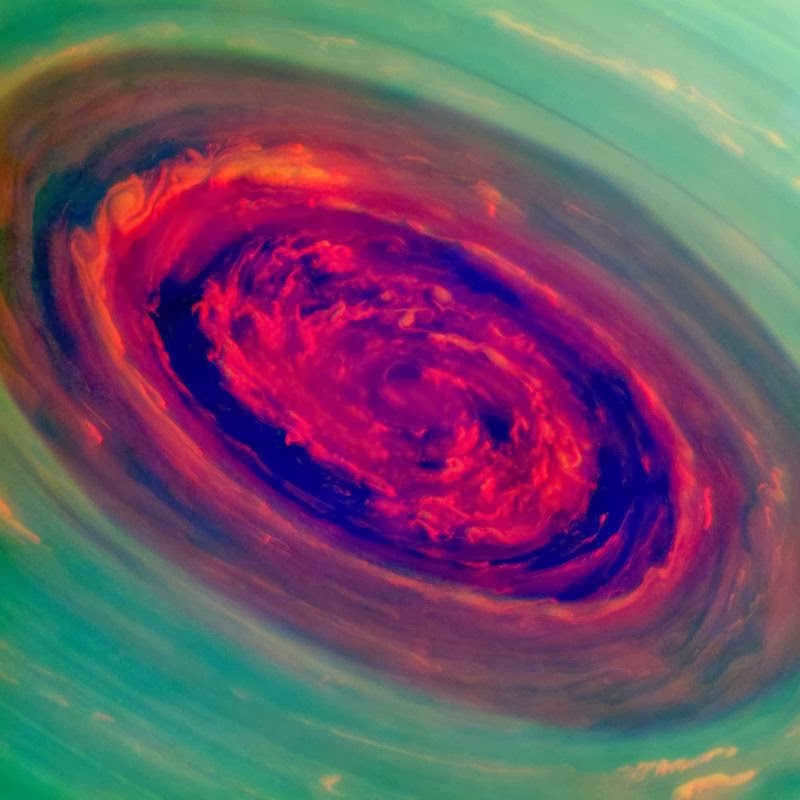
Winds on Saturn. Credit: gigant-planats.blogspot.com
The primary components of Saturn’s ring structure
Studies conducted by interplanetary spacecraft have confirmed that all four gas giant planets in the Solar System (Jupiter, Saturn, Uranus, Neptune) possess rings, but the Saturnian ring system is the most awe-inspiring and visible from Earth. These formations are not solid; rather, they consist of numerous miniature celestial bodies that orbit the planet in the equatorial plane.
Saturn boasts seven rings, consisting of three major rings and four minor rings. Each ring is coated with a layer of cosmic dust, which reflects the light emitted by the planet.
The rings exhibit a variety of colors. For instance, the first ring closest to the planet appears to be a grayish-black shade. The outermost ring, on the other hand, has a yellowish-gray tint, while the middle ring features areas that are both white and yellowish-white.
Coloration of Saturn’s Surface
The disk of the planet possesses a subdued yellow hue. Despite being one of the most radiant and awe-inspiring celestial entities in the solar system, Saturn appears somewhat faded when compared to its neighboring planet, Jupiter.
Similar to Jupiter, Saturn also displays streaks on its surface, although they are not as pronounced. It is possible that these streaks are not as visible due to the presence of clouds in the lower layers of the atmosphere.
The surface of Saturn does not have a uniform coloration. Instead, the planet is characterized by distinct belts of varying hues, including:
- Yellowish gray polar caps
- Grayish-brown equatorial region
- Yellowish-white mid-latitudes
Some of Saturn’s moons, like Titan, also display a yellow tint.
Image Gallery
Only advanced astronomical equipment can fully capture the true colors of Saturn. The Hubble Space Telescope or interplanetary research probes are even more effective in this regard. The Cassini spacecraft and other observatories have already documented the thin cloud cover on Saturn, its swirling storms, and the intermingling of hues.
The striped pattern near Saturn’s equator is intriguing, and the large spots on its surface are the result of long-lasting storms. While some images show Saturn as blue, scientists have proven that this is merely an optical illusion caused by light scattering.
Saturn’s surface. Credit: zabavnik.club Magnificent planet. Credit: glavcom.ua Amazing planet. Credit: Wikipedia
Has 3 main rings. Credit: uduba.com The rings are made of rocks. Credit: astrology.pro
It is the most beautiful and spectacular. With its vibrant yellow hue and stunning rings, this celestial body captures the attention of both experts and enthusiasts. It can be observed using a small telescope or binoculars, as it is the second largest planet in our Solar System.
Saturn stands out from the rest as the only planet with an average density lower than that of water. If it had a vast ocean on its surface, we would marvel at the sight of water splashing against its planetary terrain.
Saturn’s array of colors
Carbon compounds in the composition of Saturn’s surface give the planet’s band colors a subdued tint. The colors of any celestial body are determined by the elements present in its atmosphere. The dominant hues on Saturn consist of white clouds, which contain ammonia, and ochre, which is the color of ammonia hydrosulfate, a component of the cloud-like substances that reside just below the uppermost layer of clouds.
Seemingly, Saturn’s internal structure bears a striking resemblance to that of Jupiter. At its core lies a rocky center.
Surrounding the core is a layer of liquid metallic hydrogen with predominantly metallic properties. Further out, there is a layer of molecular hydrogen and helium, transitioning into the deeper layers of the atmosphere. These layers collectively form Saturn’s outer envelope.
There is no distinct division between the surface and atmosphere on gaseous planets. To determine the “height of zero,” which is where temperature starts to decrease (as it does on Earth), scientists consider the point where this change occurs. As altitude increases, the temperature generally decreases.
Additionally, atmospheric gases absorb solar radiation on these planets. Methane, in particular, plays a significant role in this process on Saturn.
Saturn has an atmosphere that is composed primarily of hydrogen (96%), helium (3%), and methane gas (0.4%). Below the “zero” level, the temperature remains low and the pressure is high (approximately 1 atmosphere), which leads to the condensation of ammonia and the formation of visible whitish clouds.
Research has indicated that Saturn, like Jupiter, emits more energy than it receives from the Sun. The ratio is two to one.
This phenomenon can be explained by the compression of helium in the center of Saturn. This compression generates heat, resulting in convective motion. This convective motion creates hot upward streams and cold streams in the inner layers of the atmosphere, which then move towards the deeper layers.
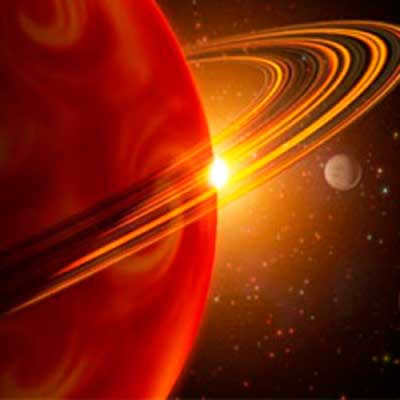
When Saturn is depicted, its distinctive rings immediately come to mind. Research conducted using automated interplanetary stations confirms that all four gas planets have rings, but only Saturn boasts such remarkable and visible rings.
As Huygens theorized, Saturn’s rings are not solid entities, but rather consist of countless tiny celestial bodies orbiting around the planet’s equatorial plane.
There are three primary rings and four secondary rings, collectively reflecting light from the planet’s disk.
In photographs captured by automated interplanetary stations, the structure of the rings is clearly visible. They are comprised of thousands of small rings, with empty space in between, resembling a pattern reminiscent of stacked plates.
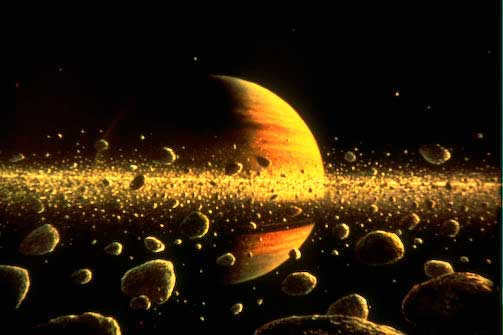
Some of the tiny rings are not perfectly circular, but have an elliptical shape. Nearly all of them are coated in a thin layer of dust.
The origin of the rings is not completely clear. It is possible that they formed simultaneously with the planet. The rings are not a stable system, and the material they are made of is likely to be periodically replenished. This is likely caused by the destruction from the impact of a small satellite.
Saturn possesses liquid metallic hydrogen within its core. It acts as a good conductor. The metallic hydrogen is responsible for generating the magnetic field, although it is not particularly strong. This could be attributed to the fact that the inclination of the axis of rotation and the magnetic field is approximately 1°, whereas on Jupiter the difference is about 10°.
Saturn’s magnetosphere extends around the planet in outer space, taking on an oblong shape as a result of the interaction between the planetary magnetic field and particles from the solar wind. This shape bears a striking resemblance to Jupiter’s magnetosphere.
Saturn is known to have 18 “official” satellites orbiting around it. However, there may be additional, smaller satellites that have not yet been discovered. The presence of these satellites exerts a gravitational influence, contributing to the formation of rings around Saturn.
The majority of Saturn’s satellites are composed of rock and ice, which is evident from their reflectivity.
Titan is not just the biggest moon of Saturn (with a diameter of over 5000 km), but it is also the largest moon in the entire Solar System, second only to Ganymede, which is a moon of Jupiter. The atmosphere of Titan is incredibly thick, being 50% denser than that of Earth. It is composed of 90% nitrogen, with a small quantity of methane present. Additionally, Titan experiences methane precipitation and even possesses bodies of liquid methane on its surface.
Did you enjoy it?
If you found the article interesting, please click the button to support our project. We appreciate your feedback!
Undoubtedly, those who have witnessed the breathtaking northern (or southern) aurora borealis at least once in their lifetime can attest that it is a truly mesmerizing spectacle. This natural wonder, visible to the naked eye on Earth, is an awe-inspiring and phenomenal phenomenon on a global scale. The vibrant and dynamic atmospheric glow, spanning hundreds of kilometers and thousands of kilometers away, gives the impression of a living, moving, and breathing entity….
However, can our planet be the sole proprietor of such a majestic display? Could future colonizers of Mars or Jupiter’s satellites, if not the native inhabitants, have the opportunity to witness something similar?
What conditions would need to be met for auroras to occur on other planets?
1. The solar wind is a continuous presence throughout the entire solar system, consisting of charged particles such as protons, electrons, and helium nuclei.
The planets and their satellites are affected by the solar wind in two main ways:
2. The atmosphere of a planet or satellite is made up of atoms that interact with the solar wind.
3. The presence of a magnetic field on a planet or satellite can direct the charged particles of the solar wind to specific regions, even if those regions are not necessarily at the planet’s poles (the angle between the planet’s magnetic axis and its rotation axis can be significant).
Now let’s examine how these factors play out on Earth.
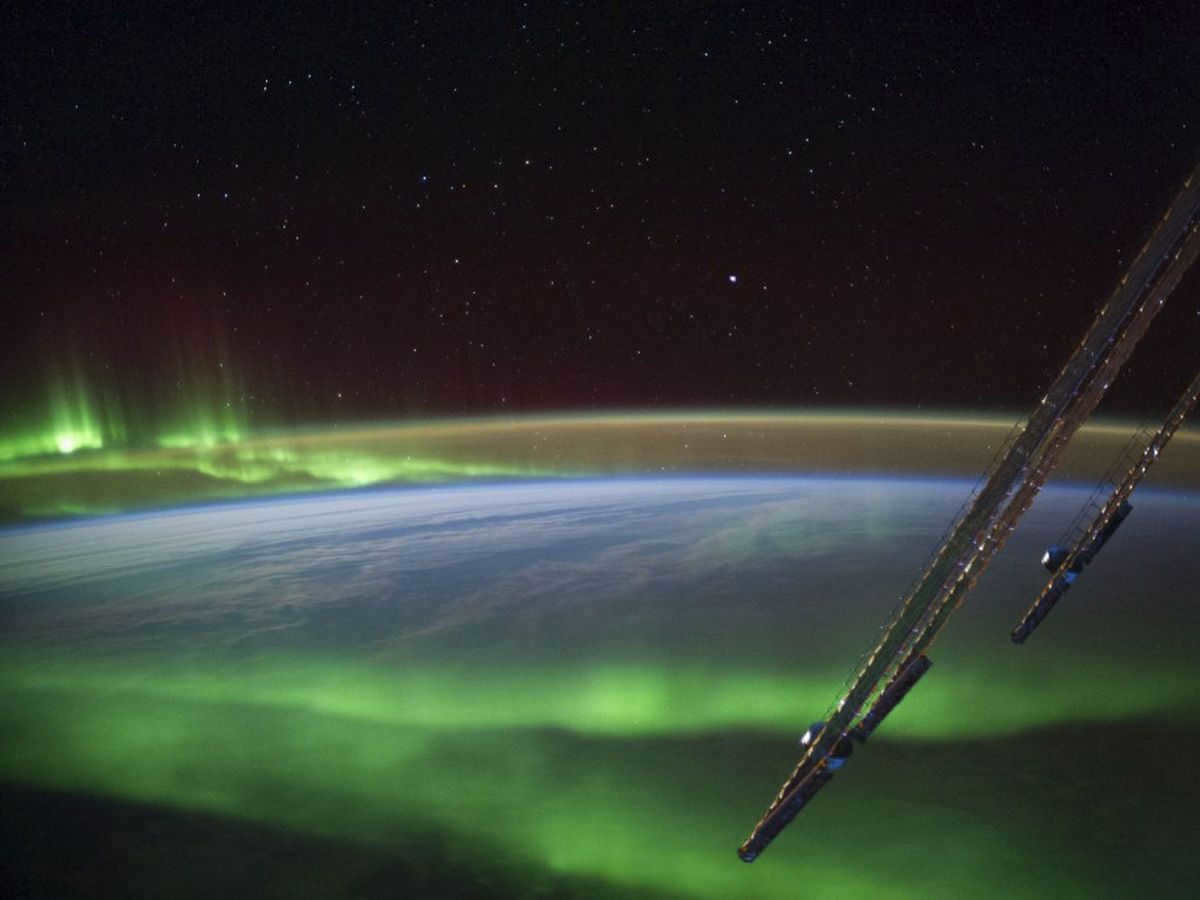

Saturn
Saturn is often referred to as the “ringed planet” due to its prominent ring system. The planet’s rings are made up of countless icy particles, ranging in size from tiny grains to large boulders. These particles orbit around Saturn in a flat plane, giving the planet its distinctive appearance. Saturn’s rings are thought to be the remnants of a moon or other celestial object that was torn apart by tidal forces.
What happens when solar wind particles interact with the magnetosphere of a planet? In the vicinity of Earth, the interaction is similar to that of a supersonic airplane. The high-speed solar wind (400-700 km/sec) collides with the planet’s magnetosphere, resulting in the formation of a head shock wave. (The speed of the solar wind in Earth’s orbit is about 10 times the speed of sound in the near-Earth plasma.)
The head shock wave acts as a magnetic barrier that alters the trajectory of charged solar wind particles around the planet. As a result of this interaction, most of the charged particles simply flow around the magnetosphere without colliding with it.
Some of the solar plasma becomes trapped in the Earth’s radiation belts, where the charged particles face difficulty in crossing the magnetic field lines. Consequently, they become stationary on the lines and can remain there for decades, spanning from pole to pole.
Additionally, another portion of the solar plasma enters the polar ionosphere without any hindrance. This occurs through the polar caspas, which are funnel-shaped regions that stretch from the Earth to the magnetopause. These caspas form as a result of the interaction between the solar wind and the Earth’s magnetic field.
Within the caspas, solar wind particles are expelled into the upper atmosphere of the planet. This expulsion occurs in two high latitude regions.
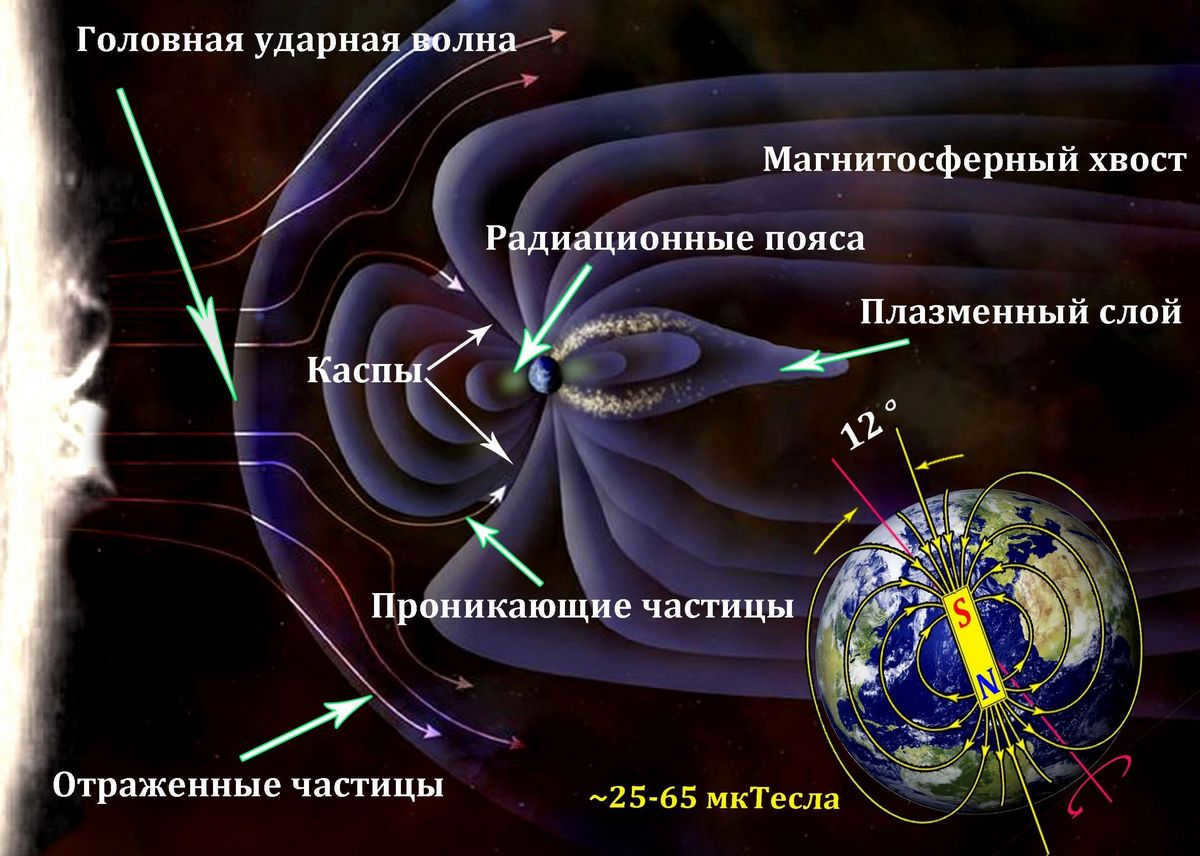
Earth’s magnetosphere
At night, Earth’s magnetosphere forms two oval-shaped regions, one in the northern hemisphere and one in the southern hemisphere, that are approximately 20° away from the geomagnetic poles. During the day, these regions are about 10° away from the poles. These oval regions are only a few hundred kilometers long in latitude.
During a strong magnetic storm, the oval is displaced towards the equator.
During periods of quiet Sun, the intensity of the polar lights is relatively low. However, during solar activity, this situation worsens. Coronal mass ejections, which are plasma from the Sun’s corona, increase the intensity of the solar wind.
Magnetospheric substorms contribute to the overall energy of the system. These events occur when the interplanetary magnetic field and the Earth’s geomagnetic field reconnect in the geomagnetic tail, located on the night side of the Earth. This reconnection causes a change in the topology of the magnetic field lines and releases a significant amount of energy, which is then converted into a new current known as an “electrojet”. The electrojet plays a role in heating and accelerating charged particles, ultimately transforming them into a high-energy plasma stream.
Given that the solar wind and coronal mass ejections from the Sun primarily consist of protons and electrons, two distinct types of auroras can be observed accordingly.
Electron auroras,
are created by streams of electrons and are commonly observed on Earth. These stunning phenomena take the form of vibrant green or purple and crimson arcs, radiant bands, ribbons, curtains, and other distinct shapes.
The process of their formation involves the electrons from solar plasma penetrating the upper layers of the Earth’s atmosphere and descending to altitudes of 400-100 km above sea level. Once there, they ionize the neutral atmospheric gases, such as oxygen and nitrogen, causing their atoms and molecules to become excited. As a result, the molecules, atoms, and ions of oxygen and nitrogen in the atmosphere emit light particles at specific wavelengths.
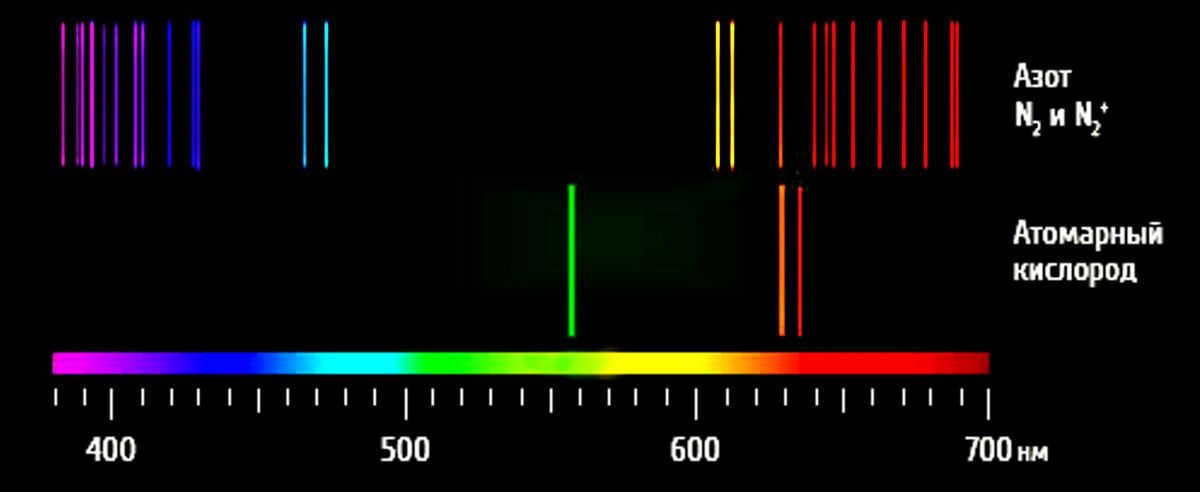
The color of the auroras is determined by various factors. For instance, the green color is caused by the presence of oxygen, which emits a strong line of light. On the other hand, nitrogen can be responsible for violet, blue, or even red colors. Each aurora has its own unique combination of colors, which depends on the constantly changing chemical composition of the atmosphere.
Electron currents are responsible for the formation of auroras on Earth, and they can be detected not only in the visible range. In fact, there are even X-ray auroras, although they are rare on Earth and are mostly observed on Jupiter.
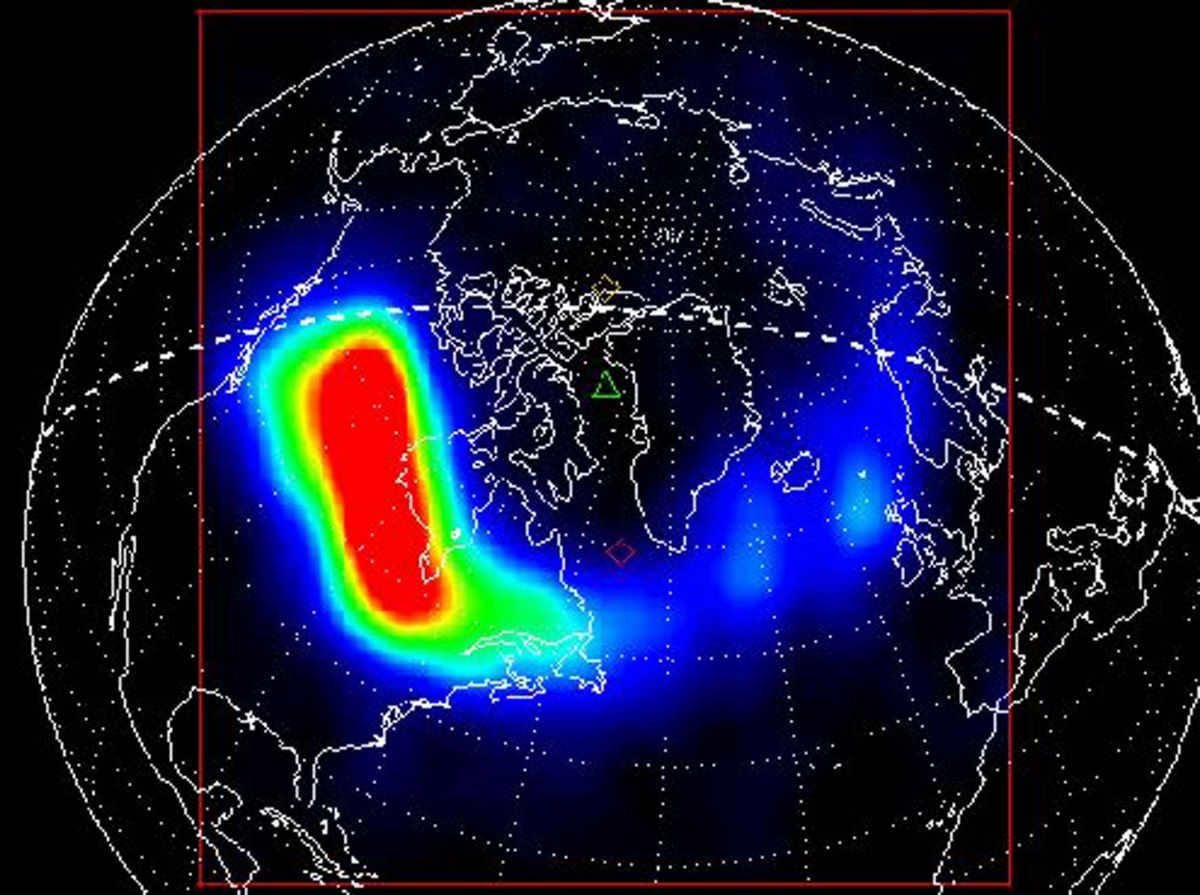
The Polar orbiting satellite recorded the most powerful X-ray polar aurora on April 11, 1997. The image displays X-rays (in traditional hues) generated in the upper atmosphere due to high-energy electron fluxes.
Proton polar lights
Proton polar lights are also a relatively rare phenomenon on Earth and have a minimal impact on the glow of the Earth’s sky.
When protons enter the Earth’s atmosphere, they collide with molecules and atoms of atmospheric gases, exciting and ionizing them. However, protons can also capture free electrons, leading to a recharging process. As a result, neutral hydrogen atoms are formed, which can emit photons in the visible and UV ranges.
The predominant type of proton auroras is a relatively broad arc that extends in an east-west orientation, with a width ranging from 300 to 1000 kilometers. Additionally, there are also instances of arcs and more diffused areas.
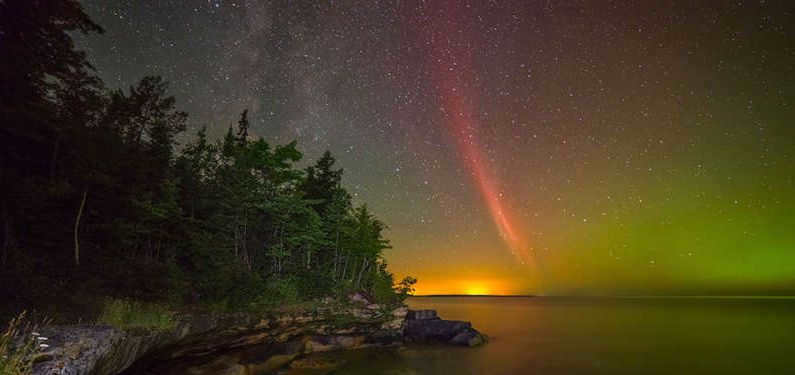
Michigan state is home to a captivating red proton arc.
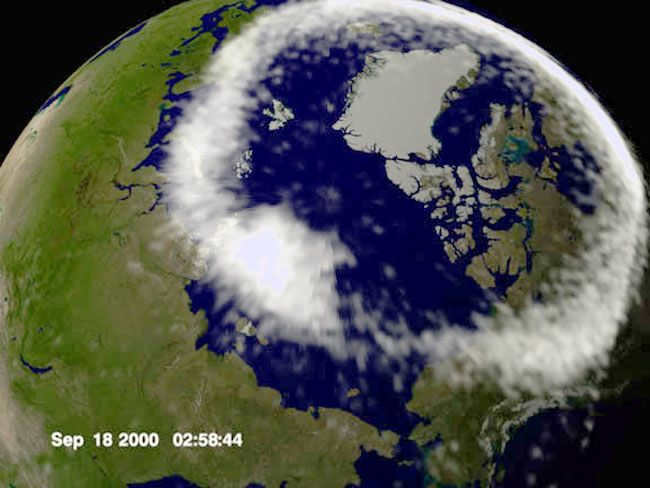
UV light reveals the vibrant proton aurora borealis. This photo was taken by the IMAGE satellite.
Now, let’s explore the auroras found on other celestial bodies.
Mercury
Even though Mercury has a magnetic field, its intensity is 100 times weaker than Earth’s. Additionally, the planet has an extremely sparse atmosphere. In fact, the atmosphere is so thin that it primarily consists of particles from the solar wind and atoms ejected from the planet’s surface. The rare collisions between these atoms and Mercury’s surface are more frequent than collisions between the atoms themselves.
Not as terrible as it may appear.
Venus presents the opposite scenario to Mercury – it boasts a dense and thick atmosphere and lacks a global magnetic field. Nonetheless, Venus does possess a feeble magnetosphere, which is induced by the solar wind itself rather than the planet.
In the 2000s, the Venus Express made a groundbreaking discovery – Venus possesses a magnetospheric tail akin to Earth’s. Within this tail, there is also a reconnection of magnetic field lines, where the multidirectional lines of solar plasma are in close proximity to each other and become short-circuited.
The solar wind, which is propelled by the process of reclosure, interacts freely with the atmospheric gases of Venus. As a result, the aurora borealis on this planet is not truly polar, or more accurately, not polar at all. Instead, it manifests as scattered and ethereal patches of light in different forms and strengths. At times, these auroras cover the entire planetary disk and are particularly prominent on the dark side of Venus.
Mars
Mars lacks a global magnetic field, but it does possess residual localized magnetization in its crust, particularly in the mountainous regions of the southern hemisphere.
The atmosphere of Mars is thin and sparse, consisting mostly of carbon dioxide. When it interacts with solar wind electrons, which are accelerated along the local magnetic field lines, rare and fleeting ultraviolet electron auroras can be observed.
One such phenomenon was recorded by the SPICAM instrument aboard the Mars Express orbital station near Cimmerian Land on August 14, 2004. The radiating region had a total diameter of approximately 30 km and a height of about 8 km.
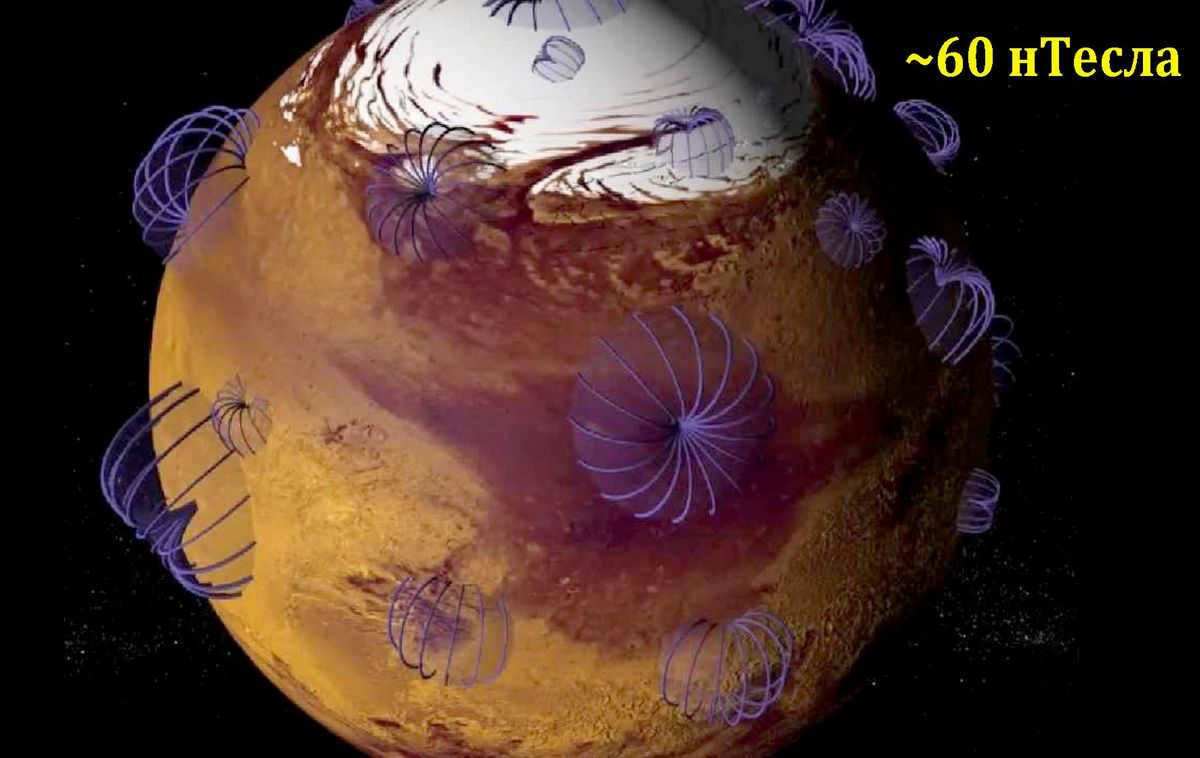
Magnetic Fields on Mars
However, proton auroras, which were initially observed during a solar storm on September 12-13, 2017 by the MAVEN orbiter, are not only more powerful but also widespread. These auroras can cover the entire planet.
Mars is surrounded by a large corona of neutral hydrogen. Protons from the solar wind, which have been charged in the corona, enter the atmosphere as neutral atoms, passing through the shock wave (which only traps charged particles) and interacting with atmospheric gases in the lower thermosphere (at altitudes of 110-130 km). This interaction generates ultraviolet luminescence.
Therefore, when solar storms occur, it is advisable for colonists on Mars to seek shelter.
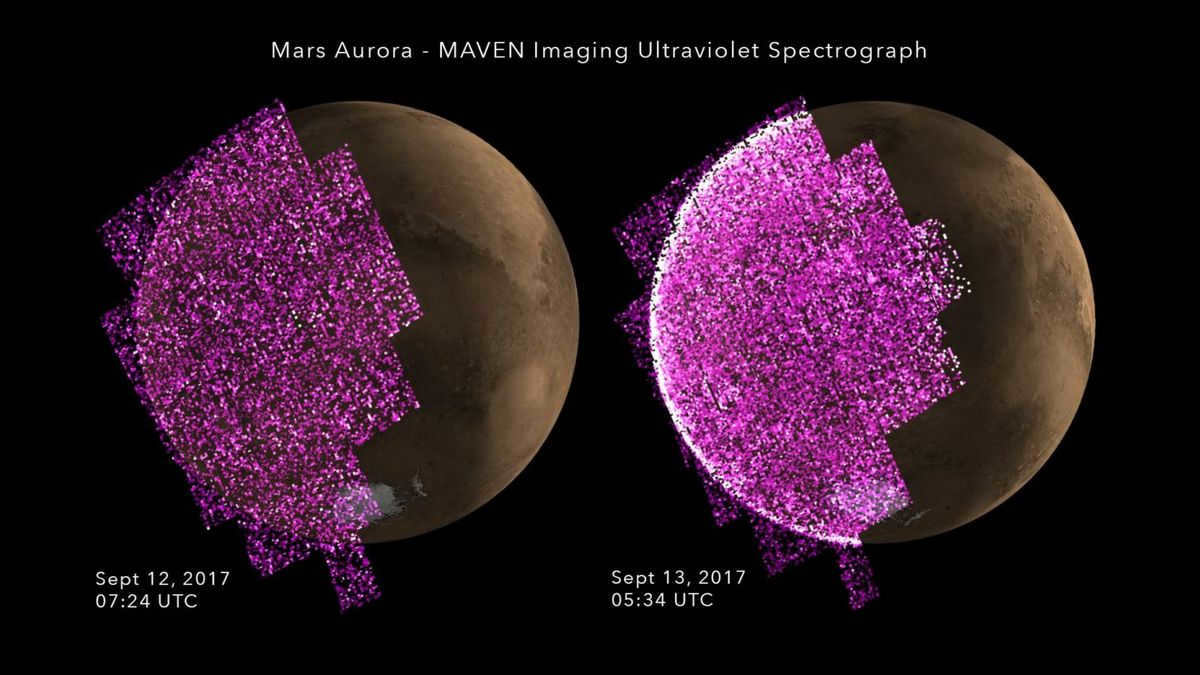
Ultraviolet data overlaid on a nighttime picture of Mars before (left) and during (right) the occurrence. The brightness of the auroral emission is most noticeable at the border of the planet’s image along the path of the glowing atmospheric layer.
Gas giants
The four gas giants in the solar system possess all the necessary conditions for the occurrence of auroras – including robust atmospheres and powerful magnetic fields.
One drawback of observing these giant planets from Earth (and generally from the inner regions of the Solar System) is that they always present their illuminated side towards the observer, making their auroras indistinguishable amidst the reflected sunlight in the visible range.
Nevertheless, auroras in other electromagnetic wavelengths can still be detected. The Hubble Space Telescope is capable of capturing UV radiation emitted by the hydrogen-rich atmospheres of the gas giants. X-rays can be detected with the help of the Chandra space telescope. Even the infrared radiation can be captured using the ground-based Subaru telescope.
The Jupiter system
It goes without saying that the largest planet in the solar system also boasts the most potent auroras. Furthermore, unlike Earth, Jupiter’s auroras are perpetual.
Another remarkable characteristic of Jupiter’s auroras is that they originate not only from the solar wind, but also from particle streams expelled by the planet’s satellites: Io, Ganymede, and Europa (which also exhibit auroras).
The presence of Io has a particularly profound impact, as this satellite is actively volcanic and possesses its own ionosphere.
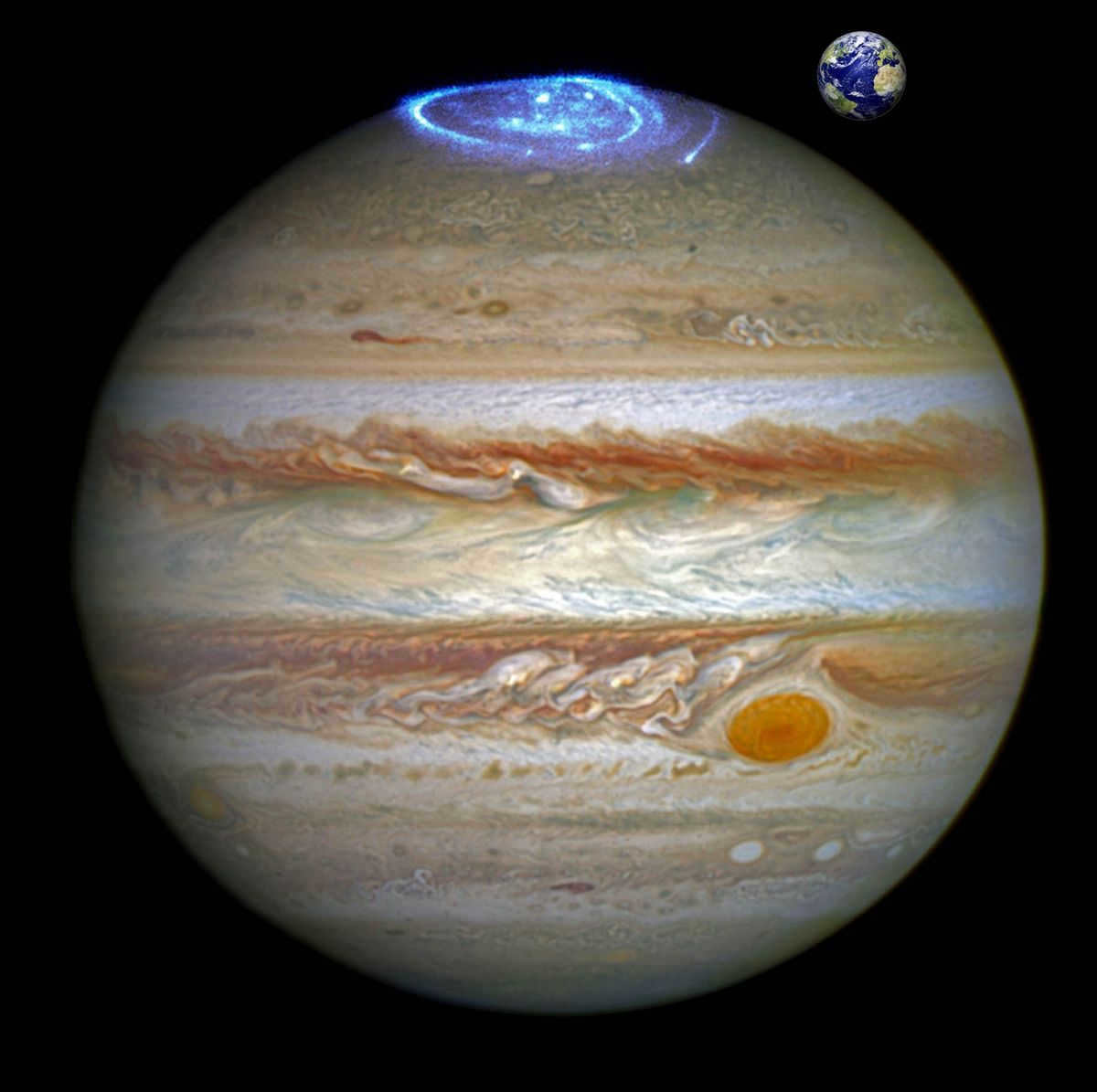
Jupiter’s aurora borealis in the north. This image is a combination of Hubble images taken in the visible and ultraviolet bands.
Little Io plays a crucial role in shaping the magnetic field of the massive planet Jupiter. The volcanoes on Io release various substances, including ionized and neutral sulfur, oxygen, chlorine, atomic sodium and potassium, molecular sulfur dioxide, and sodium chloride dust, into the atmosphere. Jupiter’s magnetosphere attracts all of this material from Io’s thin atmosphere at a rate of one ton per second.
Depending on the level of ionization, these substances either escape into a thin neutral cloud surrounding the moon (indicated by the yellow spot in the illustration) or into a plasma torus that envelops the entire planet Jupiter (represented by the red area).
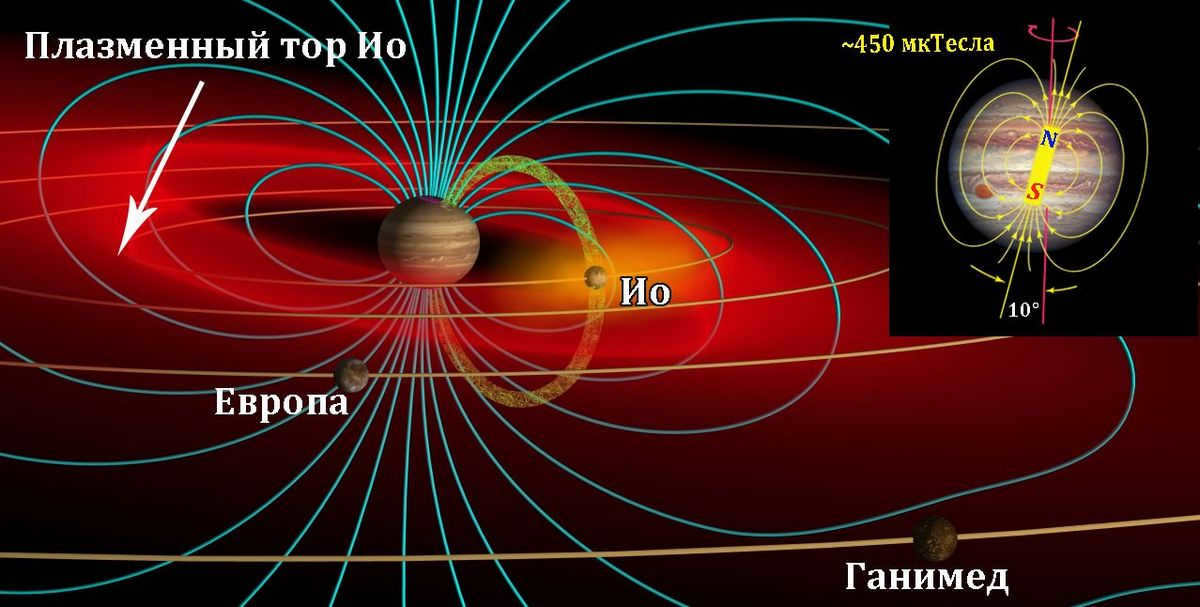
Representation of Jupiter’s magnetosphere and the influence of Io: plasma torus (red), neutral cloud (yellow), flux tube (green), and magnetic field lines (blue)
So, how does Io impact Jupiter’s auroras? It turns out that a portion of the ionized gas that Jupiter takes from its moon is directed towards its poles along the magnetic field lines (the vertical green ring in the image above). It’s as if there is a connection between Io and the polar regions of Jupiter, through which charged particles are transported. As a result, Io’s presence becomes visible in Jupiter’s atmosphere as an auroral spot that lags behind the moon’s rotation.
An animation has been produced using images from the Hubble Space Telescope in the spring of 2005. On the right side of the animation, you can observe the trace of Io.
Jupiter’s auroras are also influenced, although to a lesser degree, by its other two moons, Europa and Ganymede. The hot spots of their auroras are created through the exchange of charges between highly charged oxygen, sulfur, and potentially carbon ions.
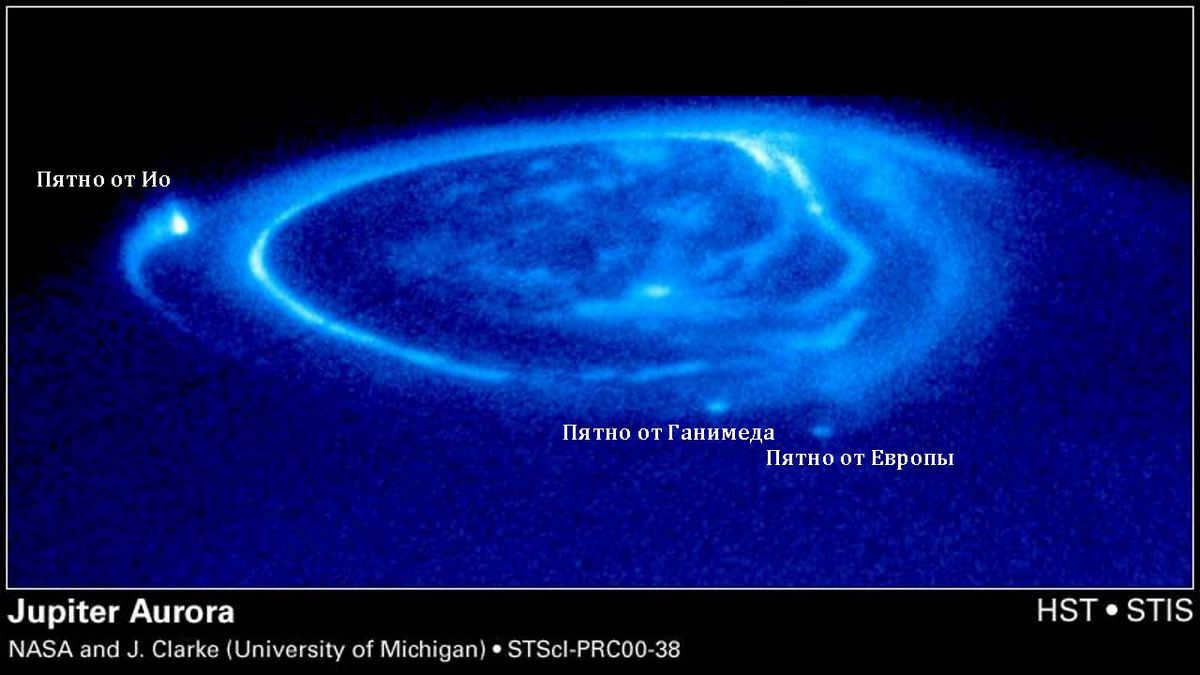
The ultraviolet auroral or hot spots on the image represent the magnetic field lines that connect the ionospheres of Io, Ganymede, and Europa to Jupiter’s ionosphere.
Occasional bright spots within the primary rings are believed to be linked to the interaction between the magnetosphere and the solar wind.
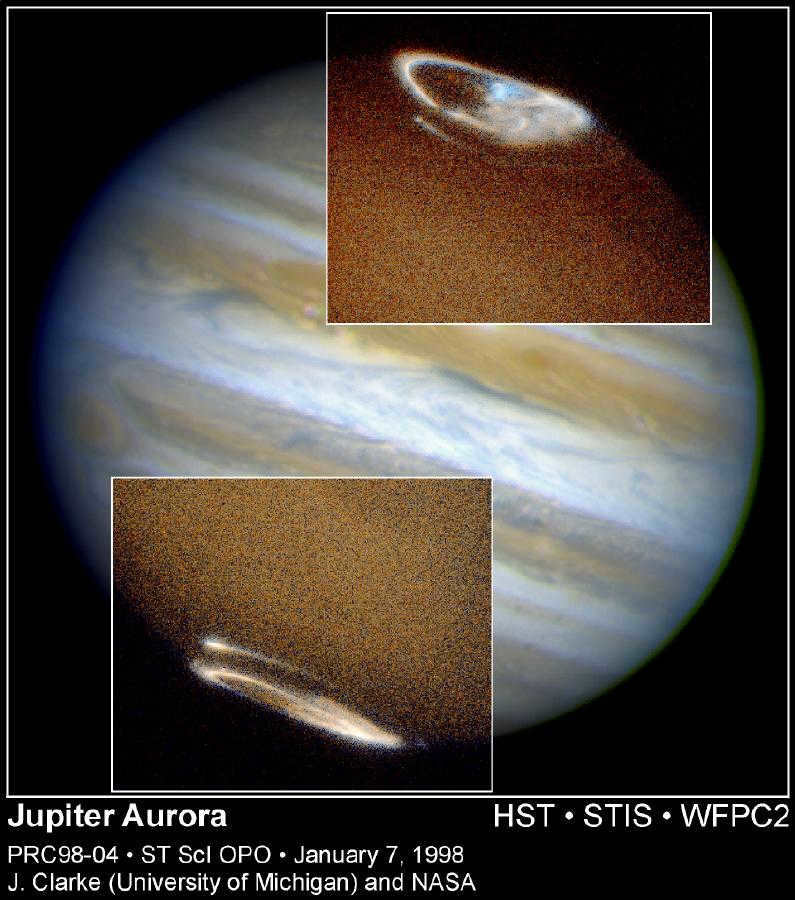
Images of Jupiter and its auroras captured by various instruments on the Hubble telescope, including those in the visible range and ultraviolet, showcase the stunning beauty of the planet.
Furthermore, the X-ray auroras on Jupiter are particularly fascinating. Unlike Earth, which only has auroras at the north and south poles that are nearly identical, Jupiter’s polar lights are “unsynchronized.” This means that the auroras in the northern and southern regions of the planet exhibit independent behavior, with changes in intensity occurring at different times.
Furthermore, the X-ray radiation emitted by Jupiter exhibits a pulsating nature. Specifically, at the south pole, the pulsation occurs every 11 minutes, whereas at the north pole, the aurora’s activity is unstable and undergoes changes independently, with varying periodicity ranging from 12 to 26 minutes, and even up to 40-45 minutes. The factors responsible for this unsynchronized and pulsating behavior remain unknown.
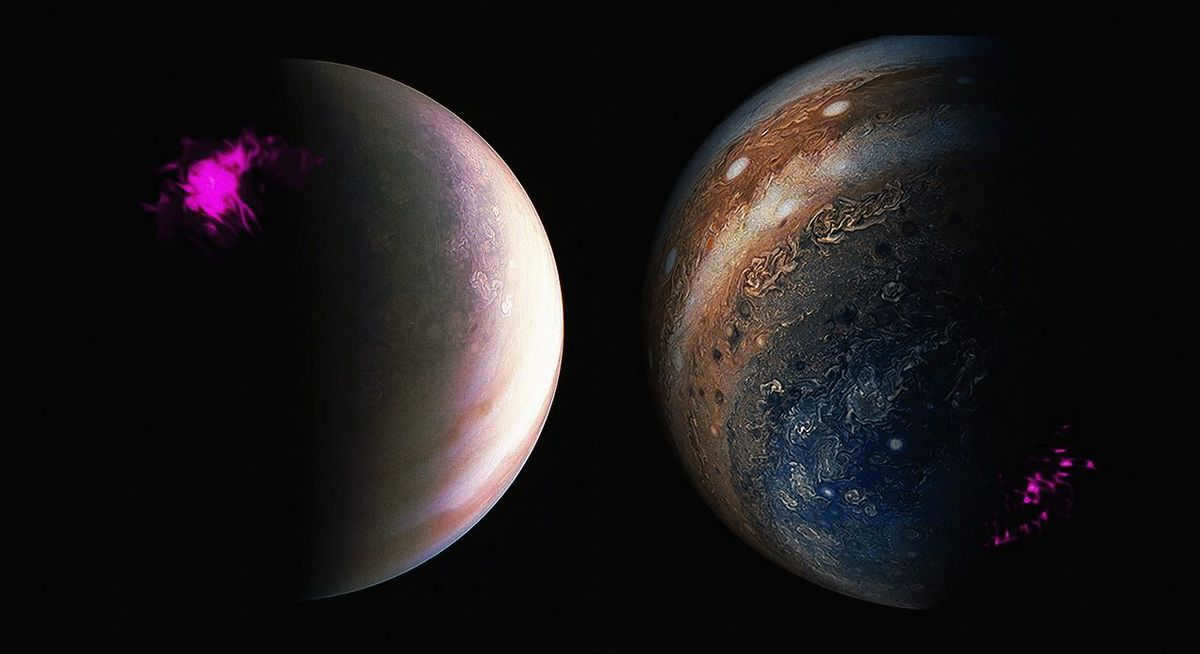
Northern and southern hemispheres of Jupiter are illuminated by X-ray auroras, with data collected from the XMM-Newton and Chandra X-ray satellites
Another query arises – how does Jupiter confer particles in its magnetosphere with the immense energies required to generate a continuous flow of X-rays?
One hypothesis proposes that the planet accelerates oxygen ions to exceedingly high energies, causing them to lose all eight electrons upon colliding with the atmosphere at a velocity of one thousand kilometers per second. The nature of this process should be unveiled through future observations conducted by Chandra, XMM-Newton, and the Juno Jupiterian station.
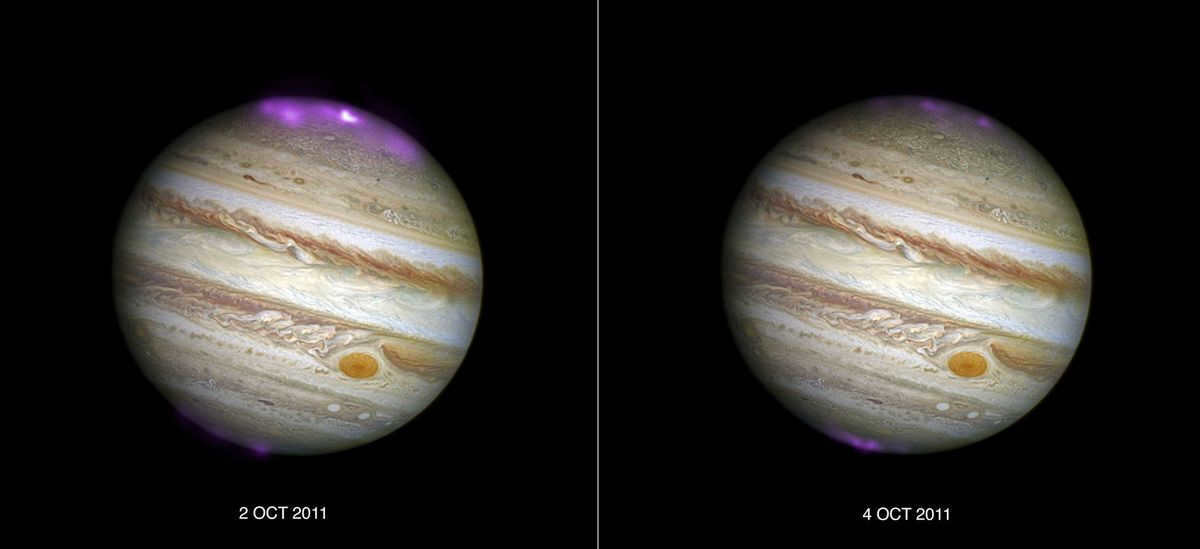
A composite image created by merging the images captured by the Hubble Space Telescope and the Chandra X-ray Observatory.
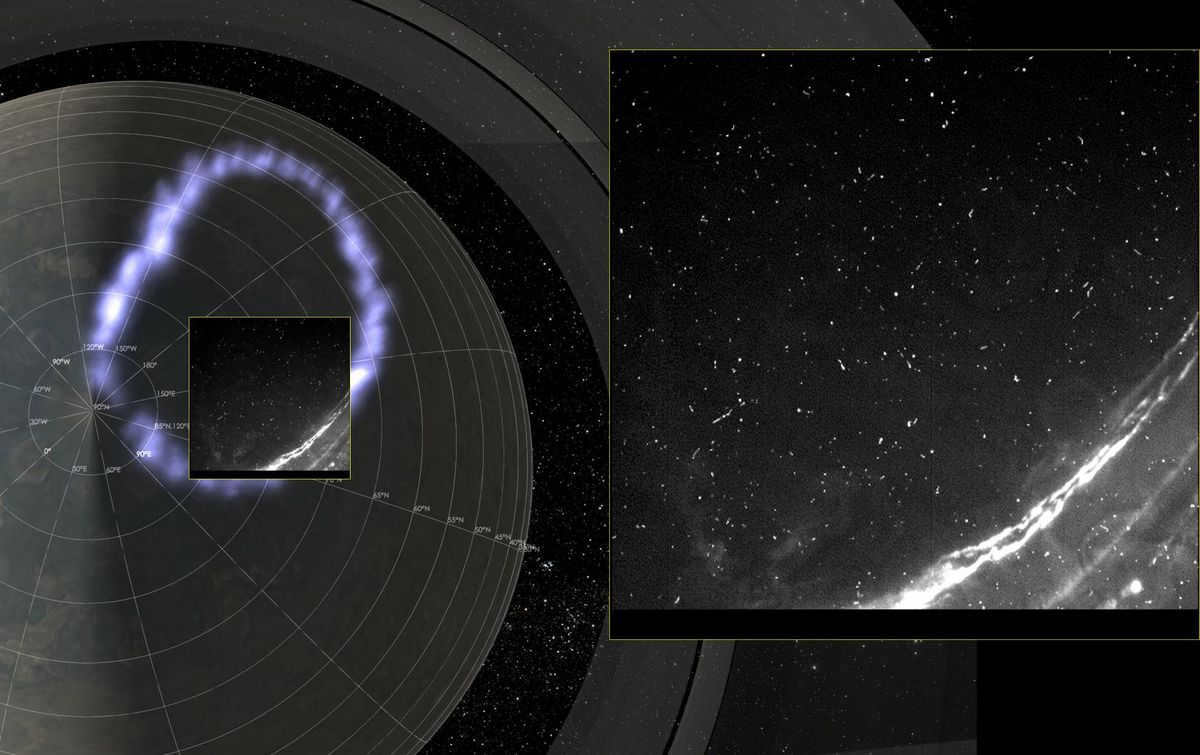
Photograph + recreation of the Northern Lights in the visible color range above the northern pole of Saturn as seen from the Juno satellite. The presence of the orbiting station around Jupiter has enabled scientists to study the previously unobservable side of the planet. This image was taken on December 18, 2018.
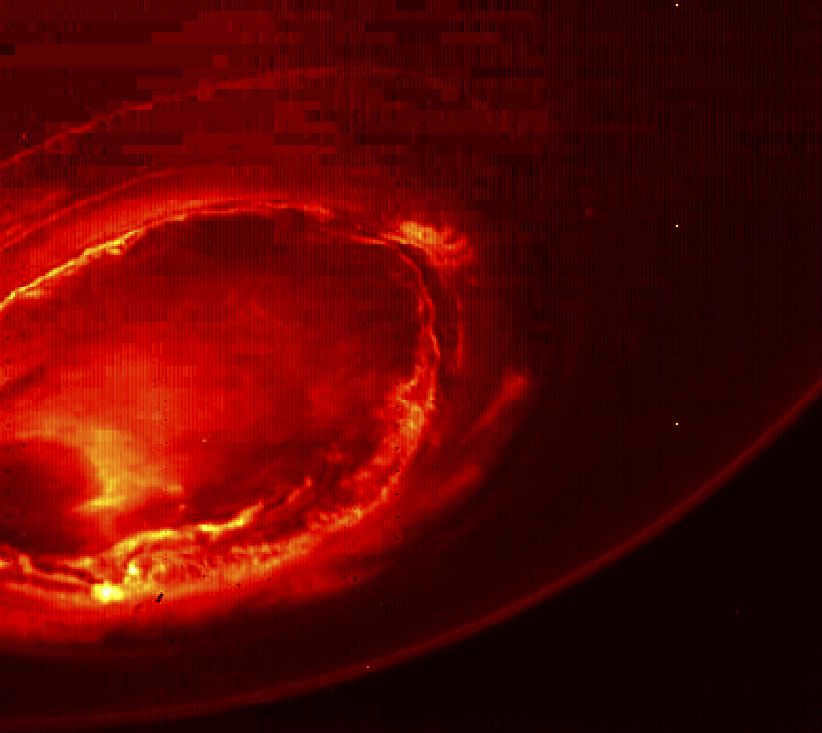
The Subaru telescope captured an infrared image of the aurora borealis at Jupiter’s south pole.
Similar to Earth, gases in Jupiter’s upper atmosphere are heated by interacting with the solar wind. However, the heating in the Jupiterian atmosphere occurs two or three times deeper, reaching the lower stratosphere.
Now, let’s talk about Ganymede. Ganymede holds the title for being the largest satellite in the solar system and is the only one with its own magnetosphere. Despite being small, Ganymede is surrounded by Jupiter’s magnetosphere. Interestingly, Ganymede also has a faint oxygen atmosphere and experiences ultraviolet auroras.
By studying the aurorae on Ganymede (which are influenced by changes in Jupiter’s magnetic field – causing the polar lights on Ganymede to “sway”), scientists have made a remarkable discovery: beneath Ganymede’s crust lies a vast amount of saltwater, which has an impact on its magnetic field.
The presence of this salty ocean creates a secondary magnetic field that counteracts the influence of Jupiter. This “magnetic friction” somehow dampens the oscillation of the aurorae. In practical terms, the swing of the aurorae is reduced to 2 degrees (instead of the 6 degrees that would be observed if the ocean didn’t exist).
According to scientists’ calculations, the ocean’s depth is 100 kilometers, making it about 10 times deeper than Earth’s oceans. However, Ganymede’s ocean is buried beneath a shell of ice that is 150-170 kilometers thick.
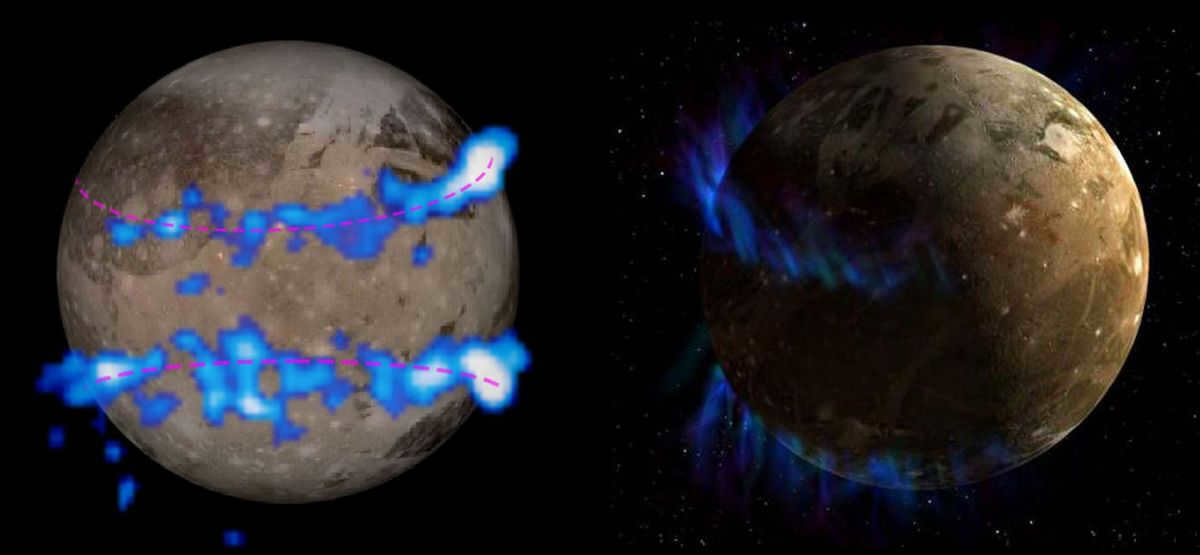
Combined Hubble photo in visible and UV + visualization of Ganymede.
Saturn’s system
Saturn also possesses auroras, so where might they originate?
Enceladus is actively “volcanic” in this area, with its southern polar region constantly emitting fountains of water vapor containing ice particles into the atmosphere surrounding the moon. These emissions can reach several hundred kilometers and even become part of the E ring, the orbit of Enceladus.
A portion of this water vapor becomes ionized and contributes approximately 100 kg per second to Saturn’s magnetosphere in the form of various ions and radicals, including hydro-, hydrogen-, oxygen-, and others.
Nevertheless, these factors alone are insufficient to expand the massive giant’s magnetosphere to match the vastness of Jupiter’s. Consequently, the occurrence of auroras on Saturn is significantly more reliant on the strength of the solar wind compared to Jupiter. In this aspect, the auroras on Saturn bear resemblance to those witnessed on Earth.
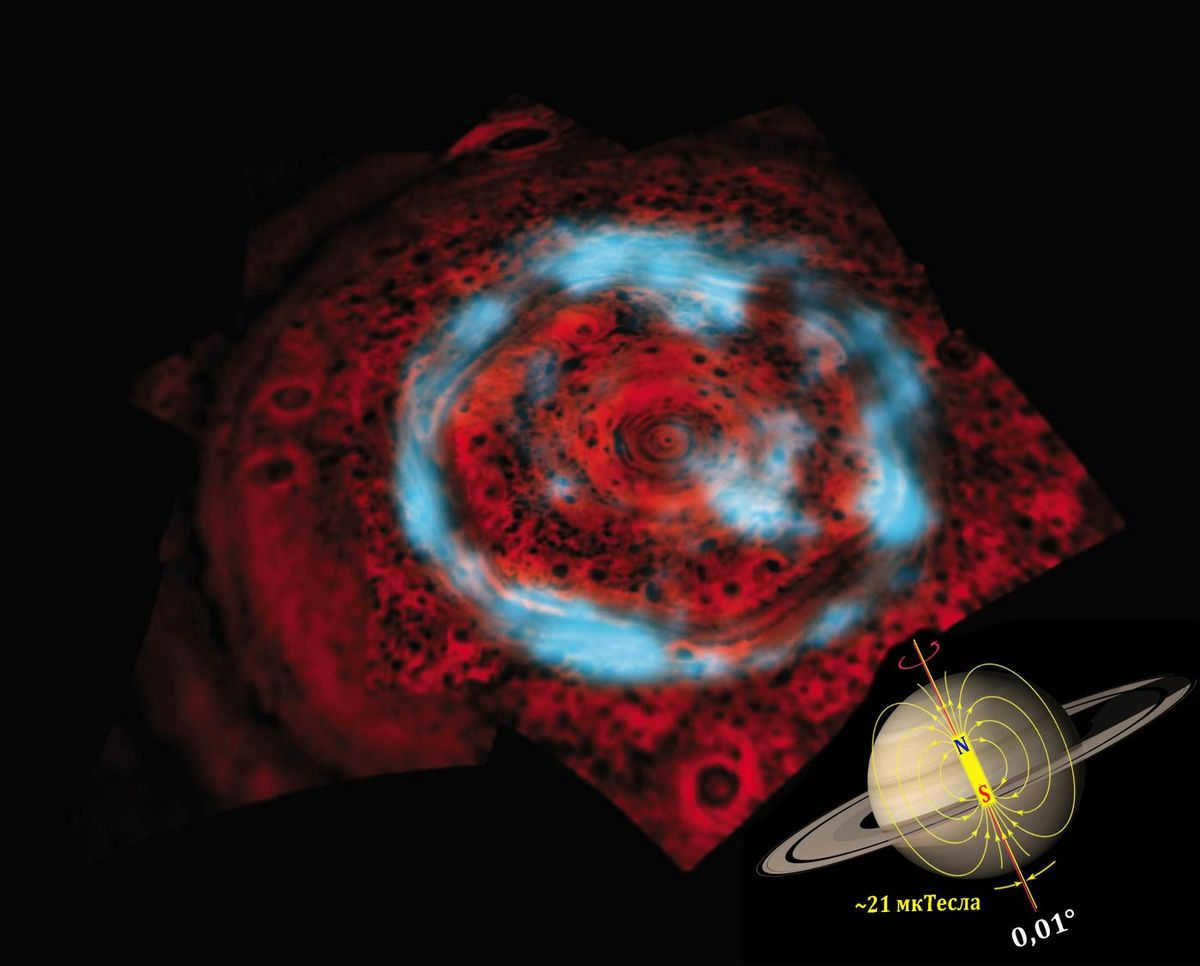
The image above shows Saturn’s northern aurora borealis, captured by the Cassini spacecraft using infrared technology (4 microns, represented in blue). The clouds beneath it have been colorized in a reddish hue (5 μm). Notably, the hexagonal cloud structure previously observed can be seen directly below the auroras.
Similar to Earth, polar auroras on Saturn take the form of closed or incomplete rings around the magnetic poles.
“The polar lights on Saturn exhibit remarkable variability. One moment, you may witness a breathtaking display of swirling lights, and the next moment, they may vanish. In 2013, for instance, we observed an extraordinary range of auroras at both of the planet’s poles, ranging from steady and luminous rings to incredibly fast bursts of light streaking across the pole,” remarks Jonathan Nichols from the University of Leicester in England.
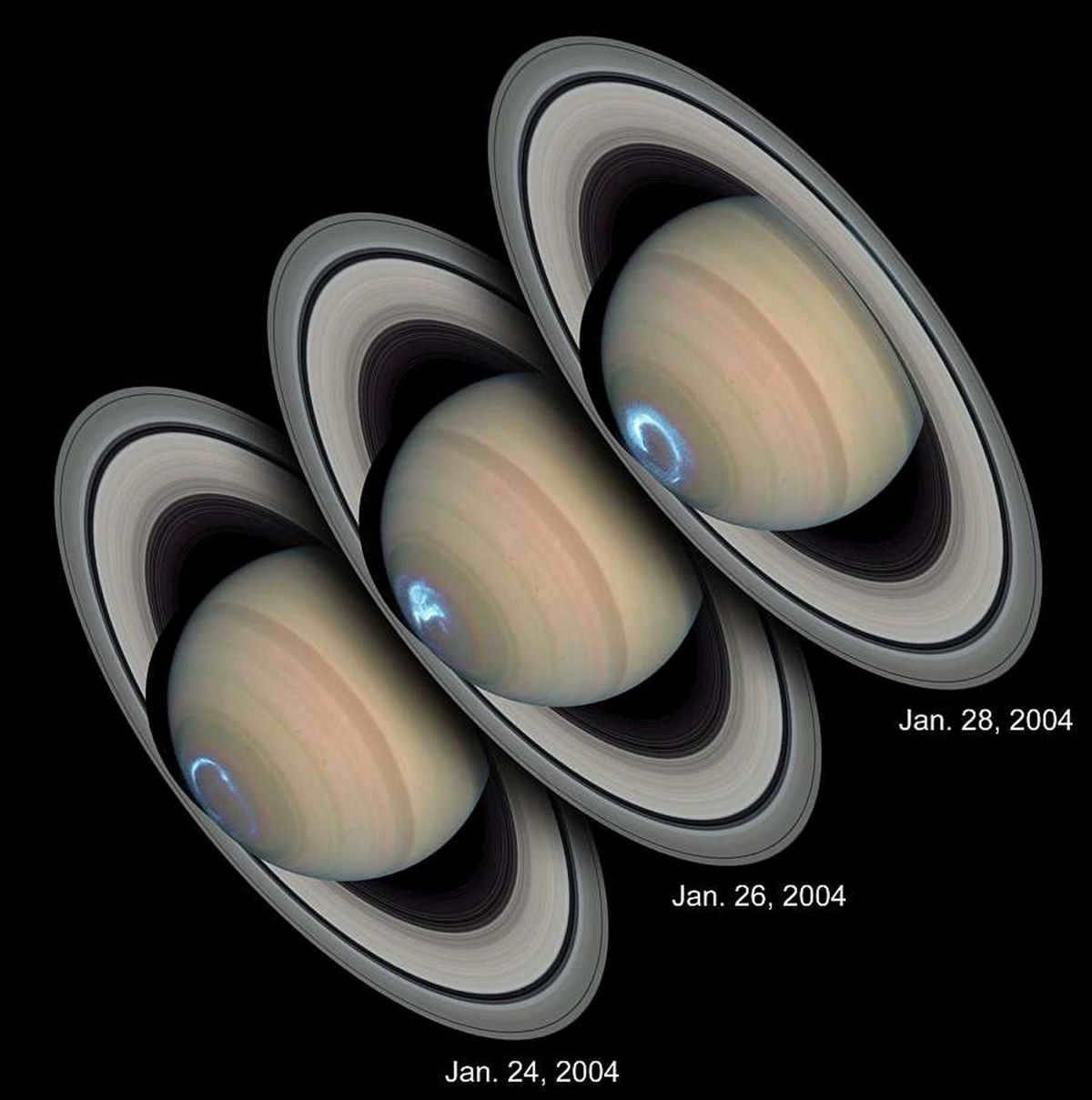
Collaborative efforts between the Hubble telescope and the Cassini spacecraft have yielded remarkable images of Saturn’s South Pole. Utilizing ultraviolet technology from Hubble and visible, infrared, and radio bands from Cassini, these three images capture the awe-inspiring beauty of Saturn. Taken over a span of two days, each photograph offers a unique perspective of the planet.
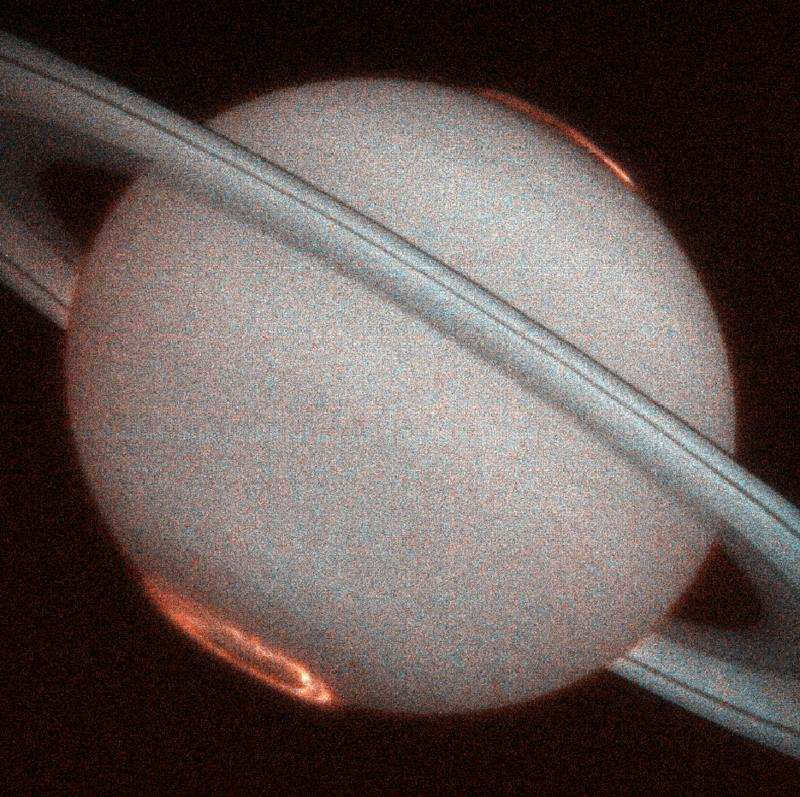
And Saturn in ultraviolet light as captured by Hubble.
Thanks to Cassini’s ability to observe in visible light, scientists were able to determine the colors of Saturn’s auroras. While Earth’s auroras have green hues closer to the surface and red hues at the top, Cassini’s cameras revealed that Saturn’s auroras have red hues closer to the planet’s center and purple hues in the upper atmosphere.
An exceptionally brilliant aurora borealis on Saturn, captured up close by the Cassini mission on November 29, 2010. The aurora stretches downward from the planet’s surface (occupying the upper portion of the image) for 1400 km. Dashed lines represent parallels and meridians, while the dashes at the bottom of the photo depict stars.
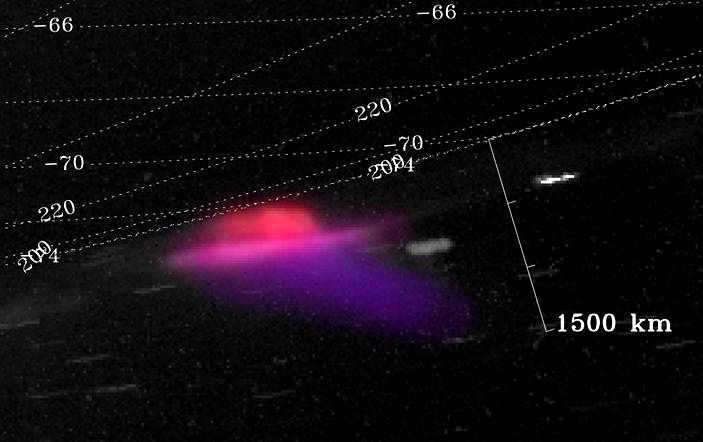
Uranus and Neptune
Uranus presents a number of unique characteristics. Firstly, it is tilted on its side, with its axis of rotation not passing through the geometric center of the planet. In fact, the axis is off by a third of its radius, resulting in a significant misalignment. Additionally, the magnetic field of Uranus is also tilted, with a tilt of 59° from the axis of rotation.
Neptune, on the other hand, has an even greater misalignment. The axis of its dipole is shifted 14,000 km away from the center of the planet, which is approximately 0.57 of its radius. Furthermore, the center of the dipole is shifted 6,000 km to the southern hemisphere. As a result, the strength of the magnetic field at the southern magnetic pole is 10 times higher than at the northern magnetic pole. However, the inclination of Neptune’s magnetic field is smaller, measuring at 47°.
Despite the “curvature and deviations” of the axes, the magnetic fields of the ice giants are not weak. Uranus is nearly as powerful as Earth, while Neptune is only 2-3 times smaller. Consequently, these planets possess magnetospheres and experience shock waves, and with their robust atmospheres, they should also have polar lights.
The challenge in observing auroras on Uranus and Neptune lies in accurately predicting the “arrival time” of a coronal ejection from the Sun. Even for Earth, it takes a day or two or three for high-energy particles to travel, making it impossible to determine the exact timing. While the speed of ejection is known, typically a hundredth of the speed of light or thousands of kilometers per second, the outcome is influenced by the interaction of particles with the Sun’s gravitational and magnetic field.
It is possible to estimate that the occurrence of the aurora borealis on Uranus will take approximately 11 days, considering its ejection velocity of 3000 km/s and the distance of nearly 3 billion kilometers from the planet. Nevertheless, it is important to note that these calculations have a significant margin of error, and due to the scheduled operating hours of the Hubble telescope, it is impractical to continuously observe Uranus or Neptune for an extended period.
Furthermore, since no orbital missions have been conducted to the ice giants, the first recorded aurora on Uranus was only documented in 2011.
As for Neptune, there have been no confirmed observations of auroras through telescopes. However, during its encounter with Voyager 2, auroras were observed in Neptune’s atmosphere, dispersed throughout space rather than solely in the oval regions around the poles. Additionally, auroras have also been observed on Triton.
